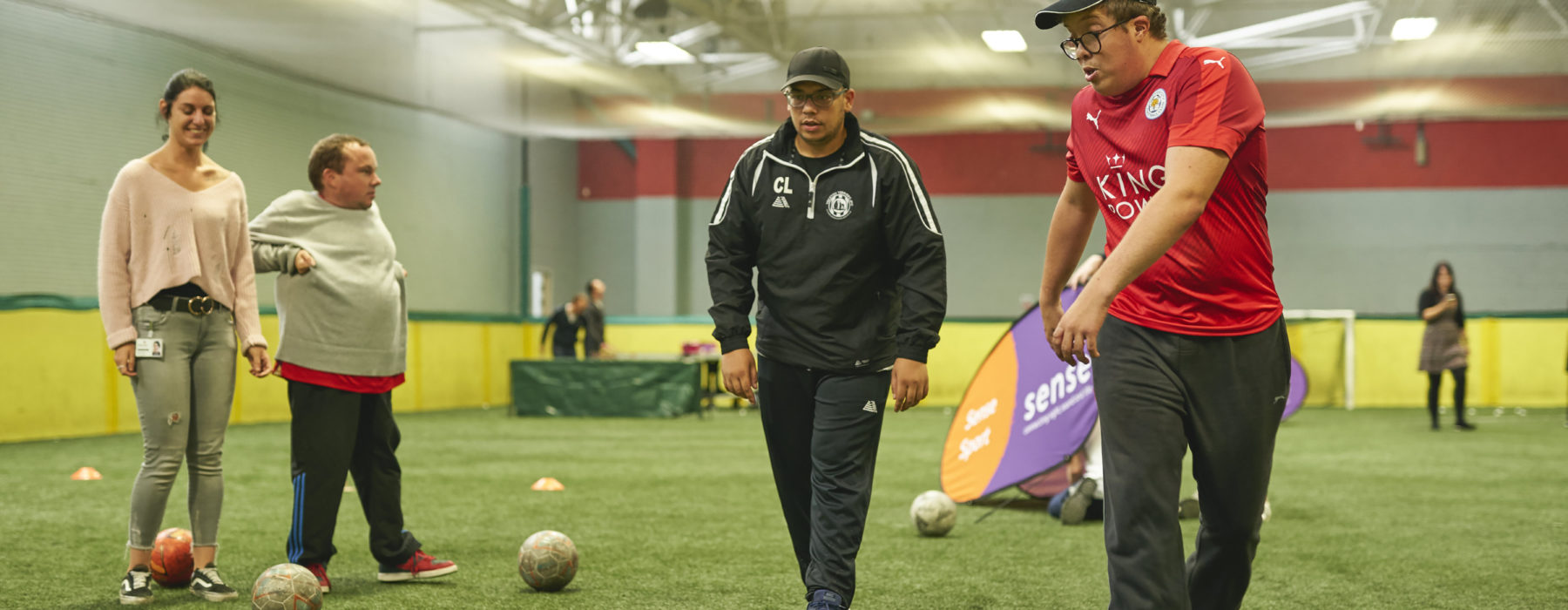Sensory football toolkit
The guide introduces sensory football, explains how to run the activity, and gives guidance on planning and evaluating a session.
What this guide covers:
If you want any support on sensory football, or other inclusive sports and movements activities, contact us at [email protected].
You can also sign up for one of our sensory football workshops to receive practical training on how to lead a session.
Introduction
Why is sport important for people with complex disabilities?
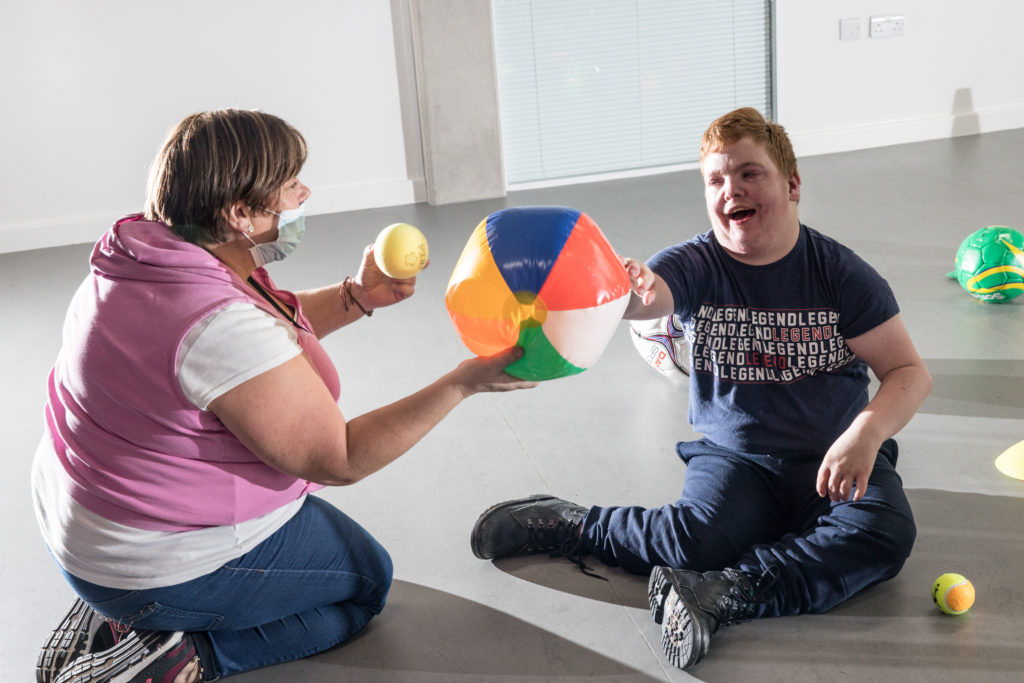
- 1.1 million people in the UK with complex disabilities.
- Three quarters of disabled people have more than one impairment.
- Physical activity is less common for disabled people (47%) than those without (67%)
- Activity levels decrease sharply the more impairments an individual has.
- Just 39% of those with three of more impairments are active.
- 4 in 5 disabled adults want to do more activity, but just 2 in 5 disabled people feel they are given the opportunity to be as active as they would like to be.
Barriers to participation for people with complex disabilities include:
- Lack of accessible facilities.
- Low self-confidence and self-esteem.
- Activities not being suitable for their needs.
Why do we need to deliver football differently for people with complex disabilities?
This resource focuses on addressing the issue of football not being delivered in an appropriate way for people with complex disabilities.
Although experiencing sport taking place can also be beneficial, those with complex disabilities can sometimes have sport “done to them”, rather than being actively involved in taking part. This means they may not engage meaningfully with the activity or experience the same benefits that their non-disabled peers experience through participating in sport, which include:
Improved physical and mental health.
- Maintaining a healthy weight.
- Making new friends.
- Gaining confidence.
- Improved ability to carry out everyday tasks.
We will demonstrate how you can make football more meaningful and engaging for people with complex disabilities, so they can experience the above benefits football can provide, as well as many more.
“At Sense, complex disabilities is defined as having two or more disabilities which mean you need a high level of support in your daily living. In particular, support to communicate, access information and move around.”
What is Sensory football?
Through experience, we have found movement-based activities, such as swimming, dance, yoga and cycling, are more engaging for people with complex disabilities than team and ball sports such as football, rugby and tennis.
“She lost interest in the football session quite quickly- the coach was asking her to dribble the ball through the cones but her disability means she could not understand this”
Movement-based activities
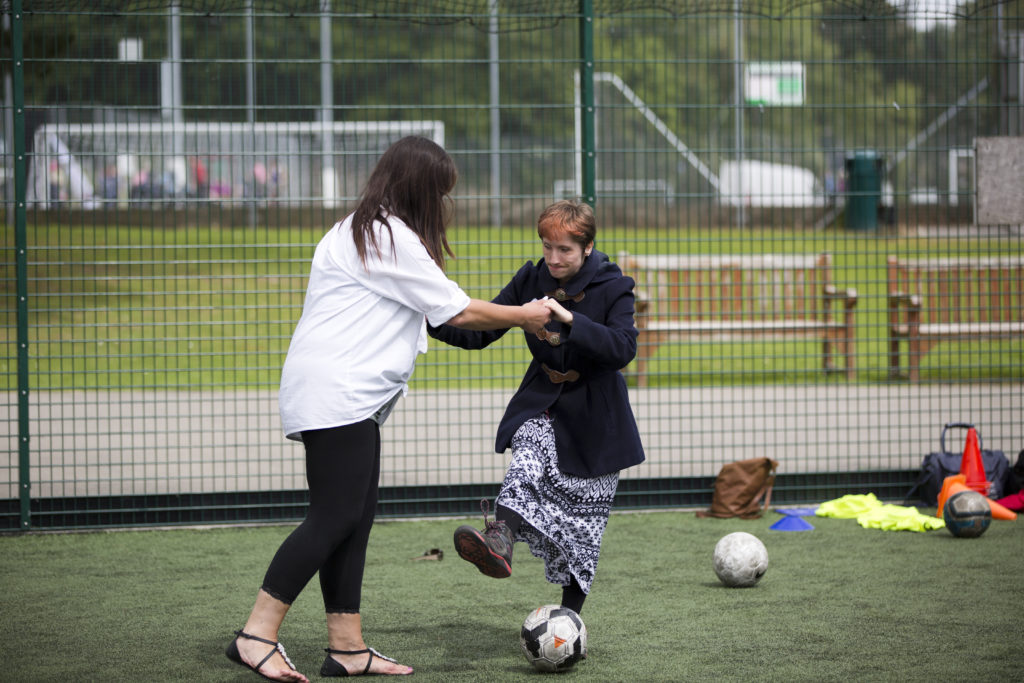
Activities like swimming, dance or cycling:
- Can be enjoyed at the pace of the participant.
- Are sensory by nature, for example the wind blowing against your face as you cycling downhill, or the splashing of water on your skin in a pool.
Team & Ball Sports
Activities like football, rugby, cricket:
- Often require the need to react quickly to an external stimulus, such as a moving ball which must be caught, kicked or thrown.
- Participants must follow complex rules.
Use a variety of tactics, which can be challenging for someone with a complex disability to understand.
Whilst we can make football more accessible for disabled people by making adaptations such as using a ball with a bell in, or making the pitch smaller, it is often the concept of rules, tactics and aims of the game which provide the barrier to participating for people with complex disabilities. Therefore, at Sense we have developed our very own Sensory football offer, making the game more accessible for people with complex disabilities by breaking the sport down into more meaningful chunks of activity.
“The simple breakdown of the skills enabled all pupils to have a go and achieve. This helped to educate staff that the pupils don’t have to achieve the whole skill, as it would be perceived in a traditional football session. It encouraged a focus on every development and achievement”.
Teacher – SEN School
Who can benefit from sensory football?
This toolkit is aimed at those working with people with complex disabilities. For example:
- SEN, school teachers and teaching assistants
- Care workers
- Families
- Football coaches
And is designed for use in:
- Schools and colleges
- Day services
- Residential and supported living services
- At home
- Traditional football facilities
The toolkit is designed to be completely accessible, so that those with little or no experience in delivering sport can lead the activities easily.
Outcomes
It is important that any sensory football programme delivered is outcome-led.
As well as being fun, there are a number of outcomes related to health, wellbeing and personal development which can be achieved by taking part in sensory football. It is important to identify which outcomes participants want to work towards, and then design activities which will help them achieve these outcomes.
There are some common outcomes which participants may experience by taking part in sensory football, such as:
- Independence – work towards doing activities more independently.
- Fun – this activity will provide enjoyment.
- Health & Fitness – improve your strength, flexibility, fitness levels or weight.
- Try Something New – experience something you haven’t tried before.
- Skill Development – this activity will improve your coordination and fine-motor skills.
- Social Skills – increase your interaction with others and develop friendships.
- Communication – develop your communication skills.
- Choice – develop the ability to exercise choice by deciding how you want to complete an exercise.
- Exploration – make use of your senses and show curiosity by exploring your environment.
These outcomes also have applications within everyday life. Participants may find that they can complete tasks such as getting dressed, holding shopping bags or communicating with their peers, with more confidence and independence.
“I kept the sessions very pupil-led so if they were really focused on a certain activity, I let that go on for longer than planned as sustained focus on an activity is difficult for some of the pupils.”
Community Foundation Sports Coach
“He looked much more comfortable with the celebrations for the goals today and had a go himself. He can be sensitive to noise but seems to enjoy the goal celebration. He knows it’s a positive sound. He has become less sensitive to the noise.”
Residential care manager
Section Two: Delivering Sensory football
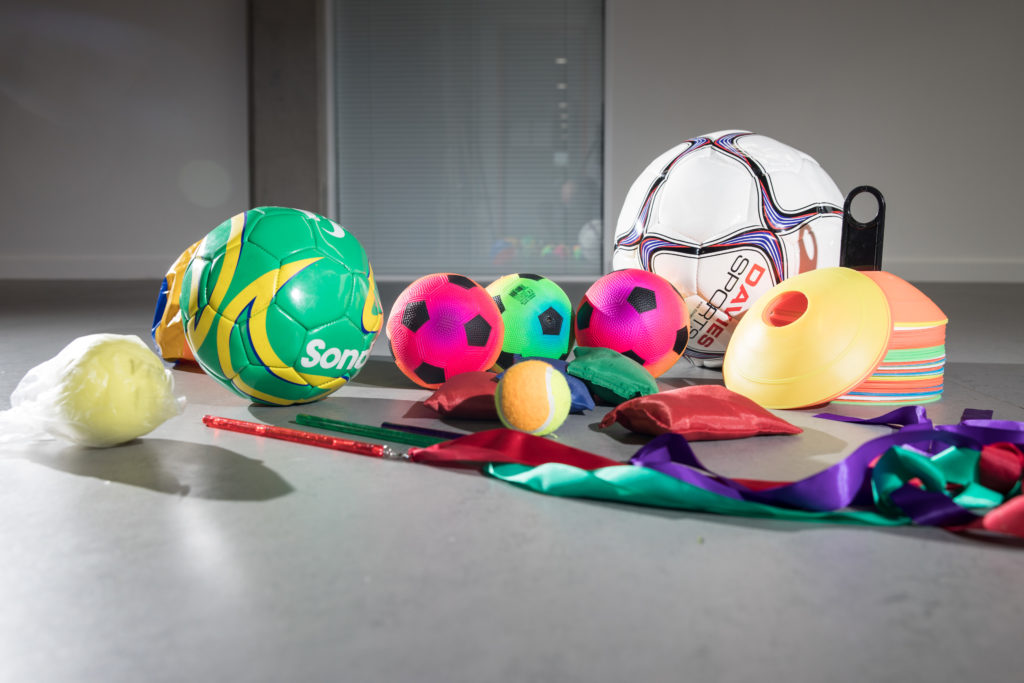
How to plan your sessions
The activities within this toolkit are designed to be done anywhere, with whatever equipment you have available.
Depending on the time, space and equipment you have, there are two different ways in which you can deliver Sensory football:
Option One
Deliver a full session, incorporating a warm up, kick off, tackle, pass, goal, and final whistle.
Benefits:
- Participants work on a wide range of different skills and therefore will achieve a variety of physical, mental and social outcomes.
- Provides a complete and rounded football experience.
Option Two
Select one skill, and focus in more depth on developing this particular skill.
Benefits
- Participants can focus on one single skill if they have a particular outcome they want to develop (e.g. focusing on a tackle to develop strength).
- Repetition of a skill helps facilitate learning in people with complex disabilities.
In this guide you will find a session plan, which you can repeat each week, using the progressions provided to make the sessions more challenging if participants are becoming comfortable with a particular activity. Equally, examples are provided to make the activities slightly easier for those who may find them challenging.
Outcomes
Look out for our handy outcomes alongside each activity, which describe the key physical, mental and social benefits that each activity will work towards. These are the primary outcomes of the activity.
You will then find a more detailed explanation of these outcomes in this guide. Remember, this is not an exhaustive list.
There are many different benefits to taking part in sport & physical activity, and each activity will work towards multiple outcomes. We have simply selected one or two of the most relevant outcomes for each activity.
Be creative, adaptable and responsive
The key to a successful session is understanding the needs of the participants you are working with, and adapting your session so that they can have the best experience possible. By tweaking the activities provided to suit your participants, or using them as a basis to create your own activities, you will ensure each participant can engage with the session in a meaningful way.
“In order to focus on certain elements in insolation, I had to pack away the balls to take away any distractions, and then get them back out later in the lesson. This helped participants get the full experience of all the elements, instead of just sticking to their favourite part.”
Teacher- SEN School
Session plan example
You can use this example session plan as a guide for delivering your own sensory football sessions. Full instructions for the activities suggested in the table below can be found on pages 16 – 24.
| What? | Why? | How? | Outcomes |
| Which skill or element of football are we focussing on? | What are the purpose and aim of this skill? | What activities can we do, which are suitable for someone with complex disabilities? | What benefits are we gaining by completing these activities? |
| Warm Up (10 mins) | ■ Getting used to your surroundings ■ Getting used to working together as a group ■ Pulse- raising ■ Preparing for the activities to come | ■ Mapping the space and equipment ■ Moving freely around the space ■ Making contact with others in the group | ■ Anticipating what is going to happen next ■ Having a better awareness of what is happening around us ■ Improved social and communication skills ■ Improved physical health More independence |
| Kick Off | Signalling the start of the sensory football session | Create your own “whistle” | Anticipating that the sensory football session is about to start |
| Tackle(10 mins) | Making physical contactUsing strengthBeingcompetitive | ■ Participant and helpers making physical contact with each other ■ Doing resistance work by pushing against or pulling objects | ■ Developing an awareness of parts different parts of the body ■ Improving strength |
| Pass(10 mins) | ■ Possessing and releasing an object ■ Passing an object from one person to another | ■ Gripping and releasing balls of different textures ■ Moving an object from one person to another using the hands or feet | ■ Improving grip and release capability ■ Improving hand- eye coordination |
| Goal(10 mins) | ■ Celebrating our achievements ■ Creating togetherness | ■ Scoring a goal in a way which is suitable for us, whether that is with our hands, feet or body ■ Celebrating each goal as it is scored | ■ Improved mobility and independent movement ■ Improved hand-eye and foot-eye coordination ■ Recognising what we have achieved ■ Sharing success with others ■ Improving communication ■ Receiving feedback on our performance |
| Final whistle | Signalling the end of the sensory football session | Create your own “final whistle” | Recognising that the sensory football session has finished. |
Warm Up
Aims and outcomes
Aims
- Getting used to the surroundings.
- Getting used to working together as a group.
- Pulse- raising.
Preparing for the activities to come.
- Outcomes
- Independence
- Exploration
- Skill development
Mapping the space
Move around the space, feeling the outline or the perimeter of the space. This could include the walls, flooring, or cones.
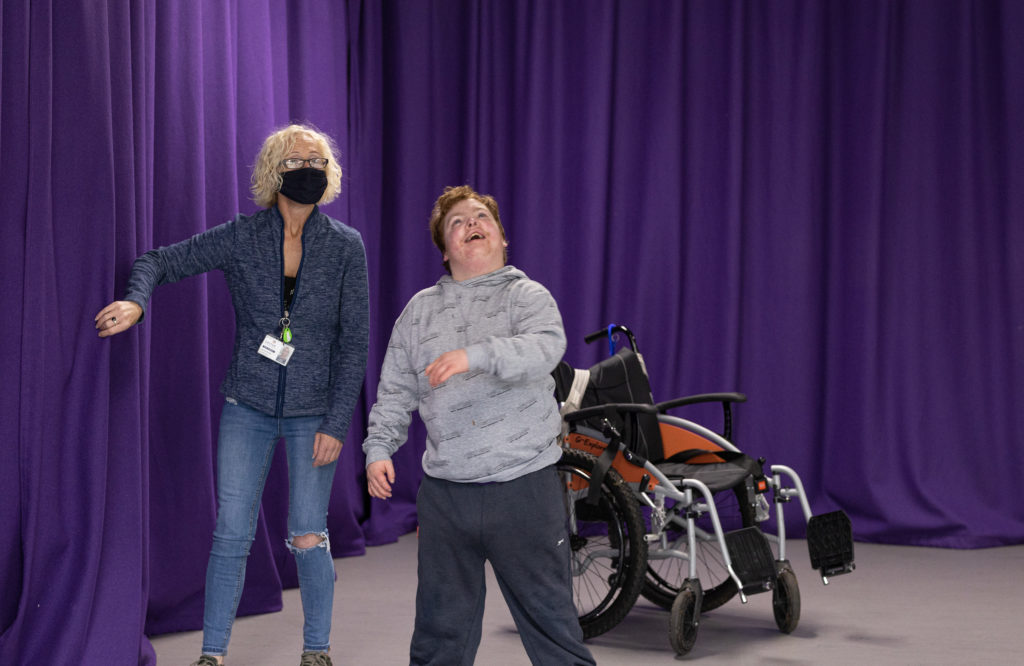
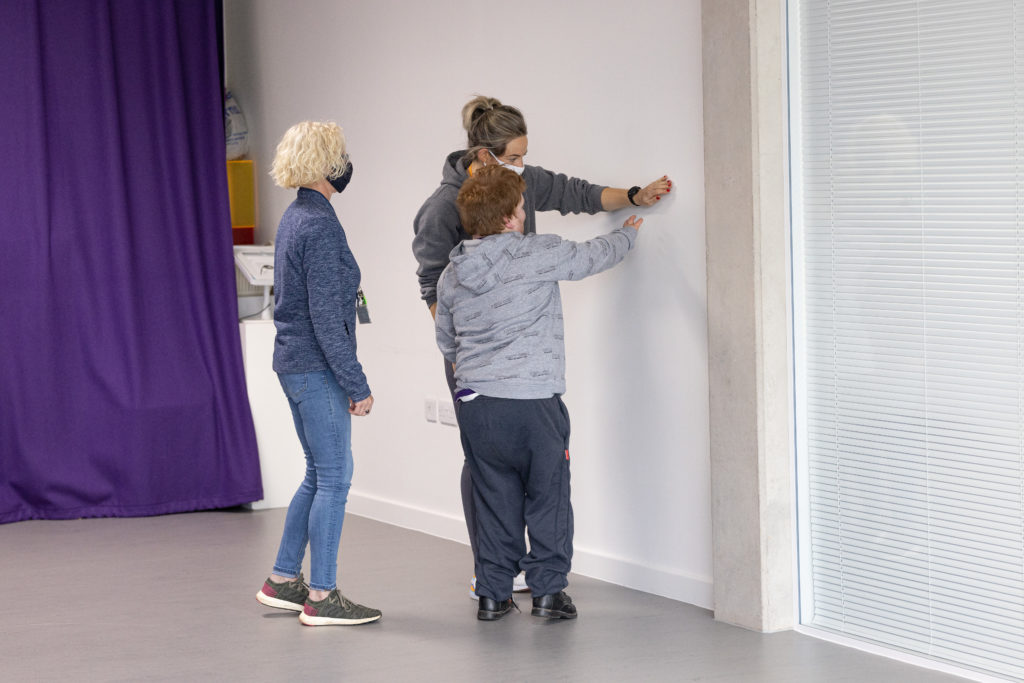
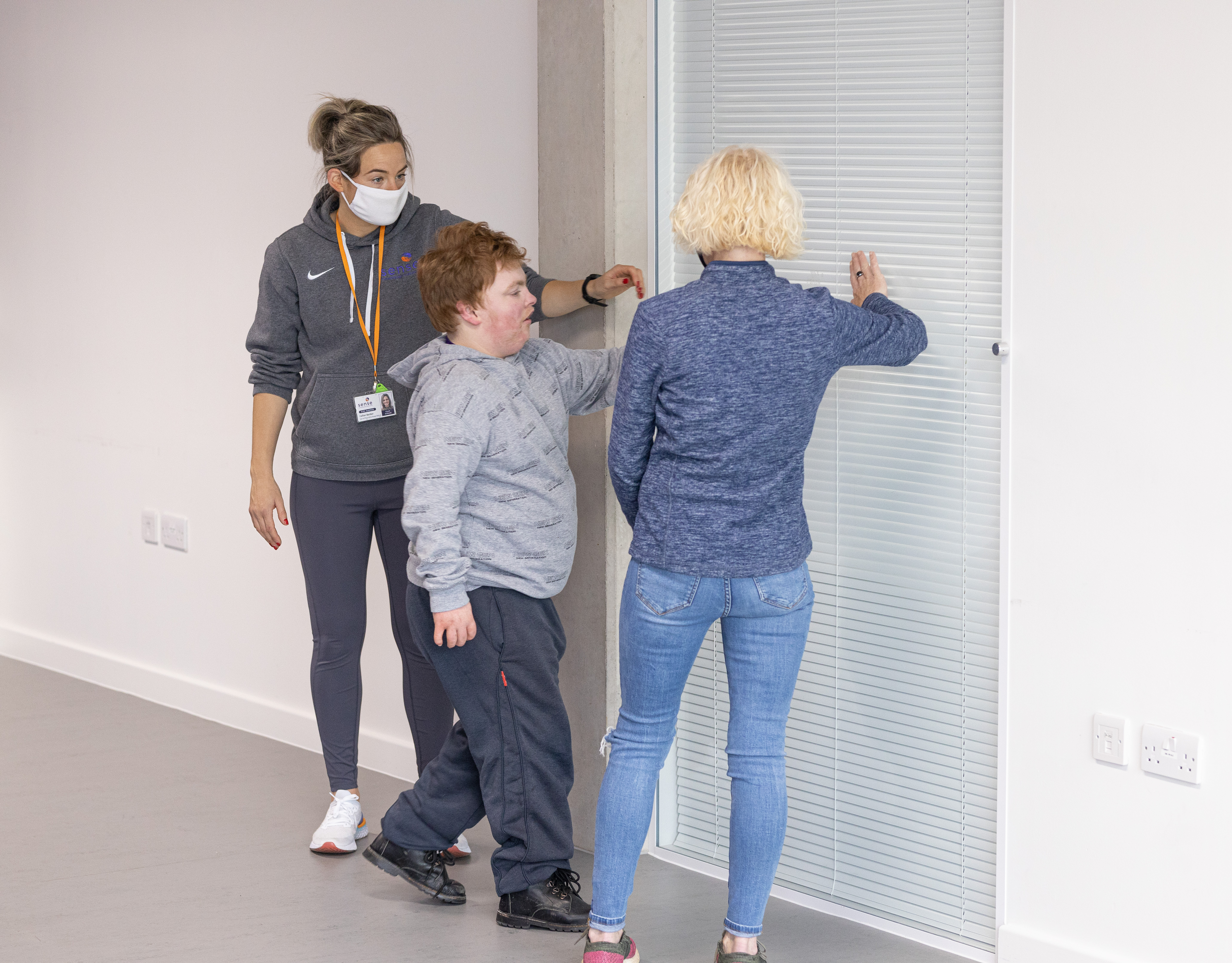
Make it easier
- Provide more support, guidance and direction to the participant when moving around and exploring the space.
Make it harder
- Encourage the participant to explore the environment more independently.
Mapping the Equipment
Pick up pieces of equipment and explore their shape, size and texture
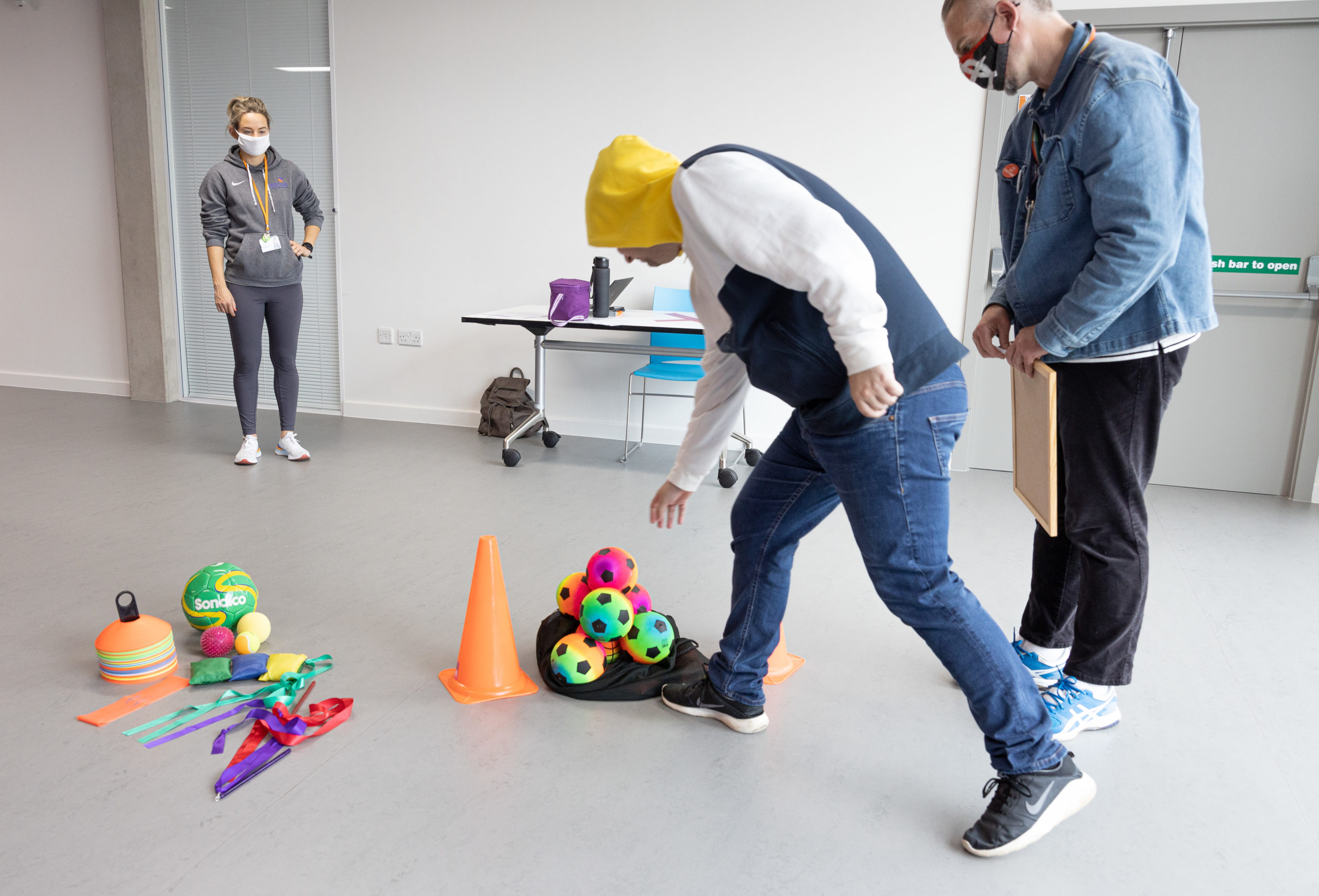
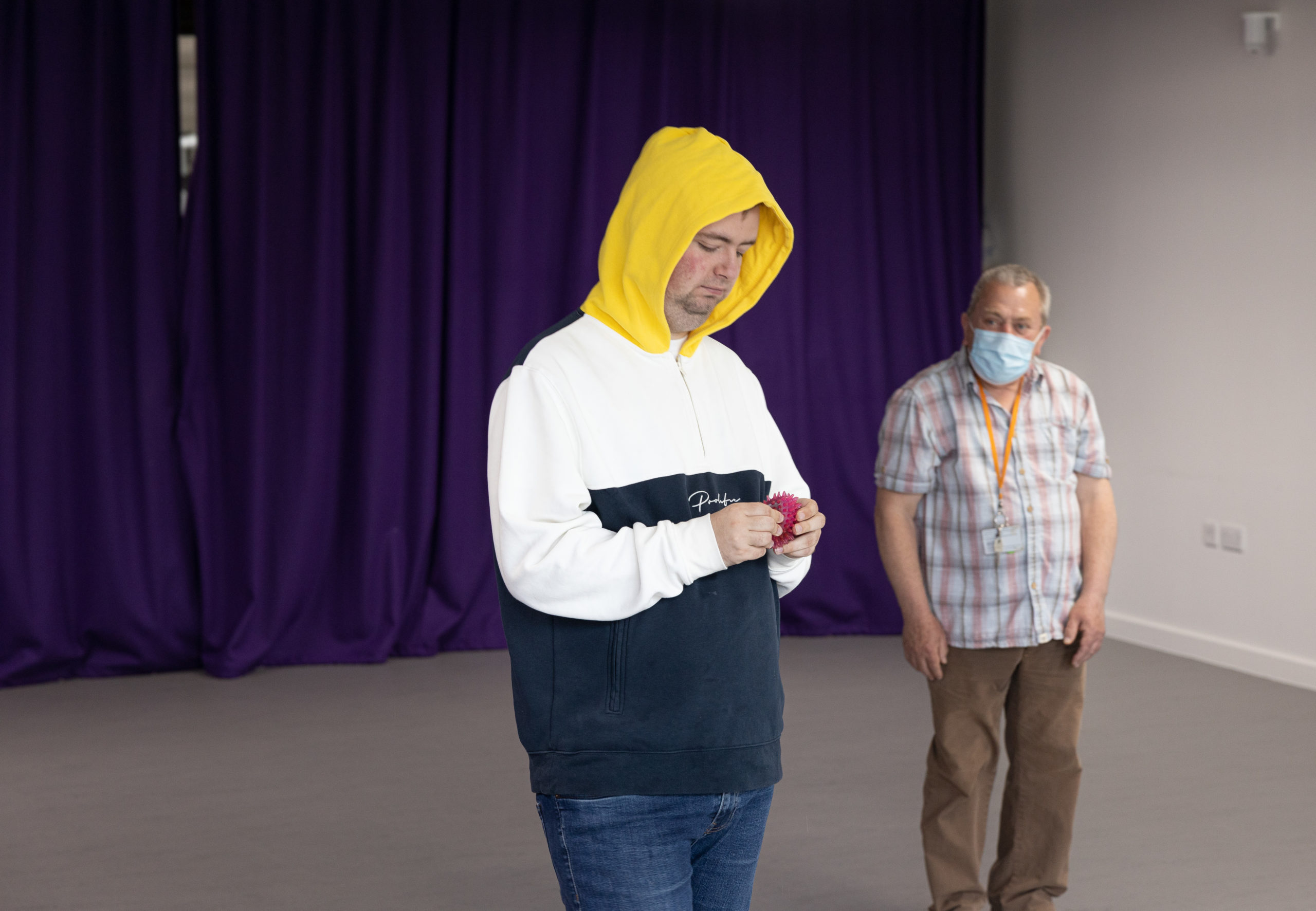
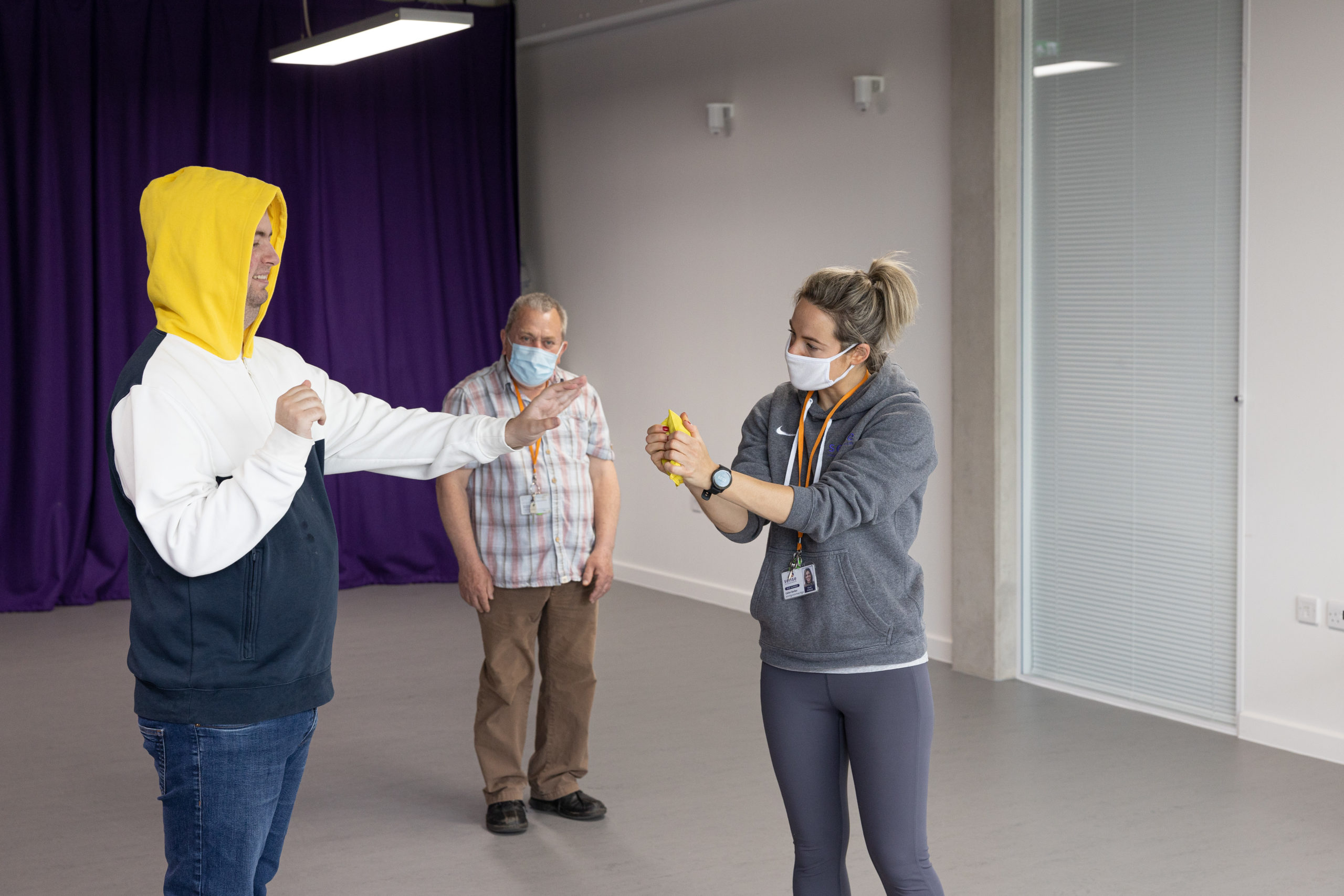
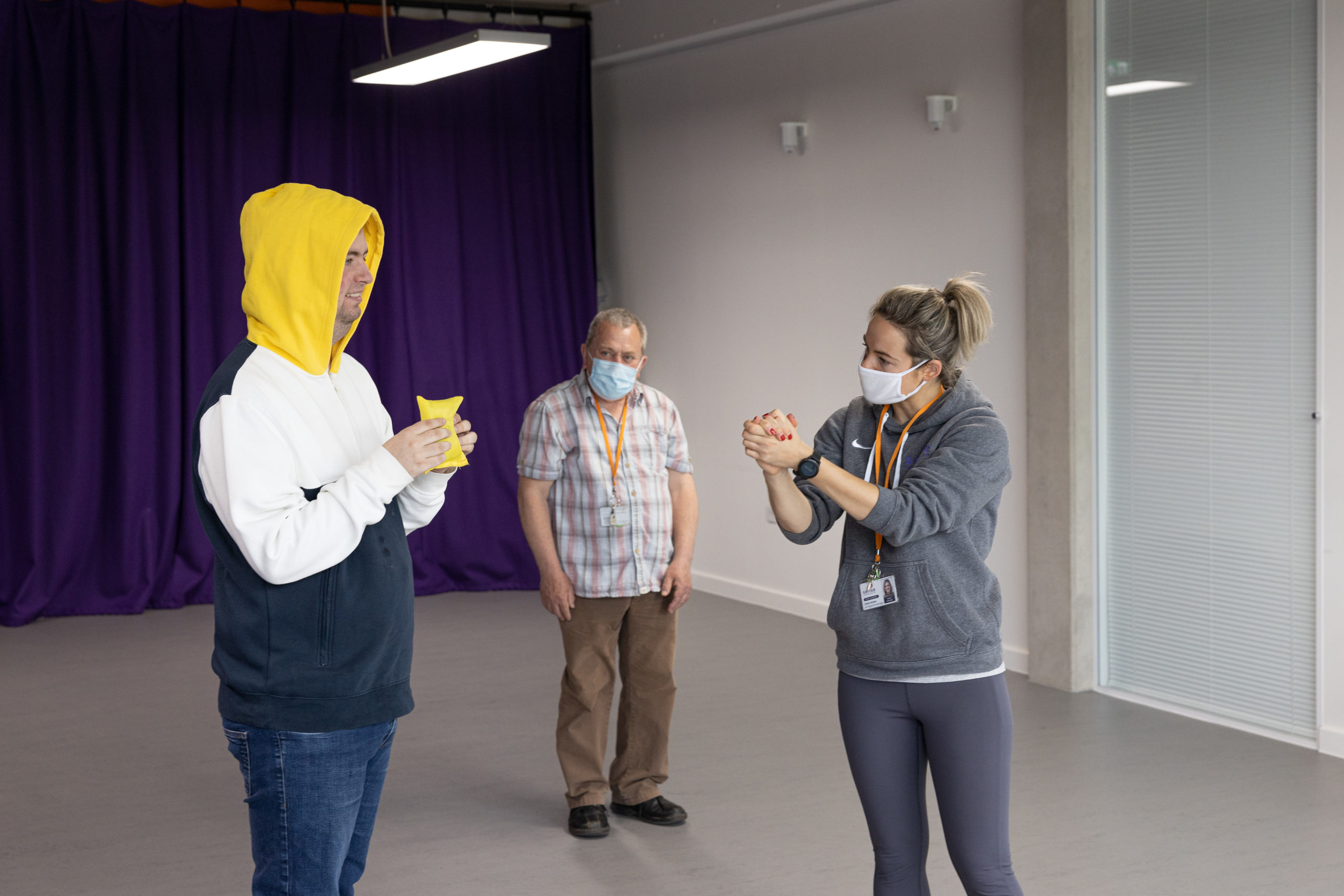
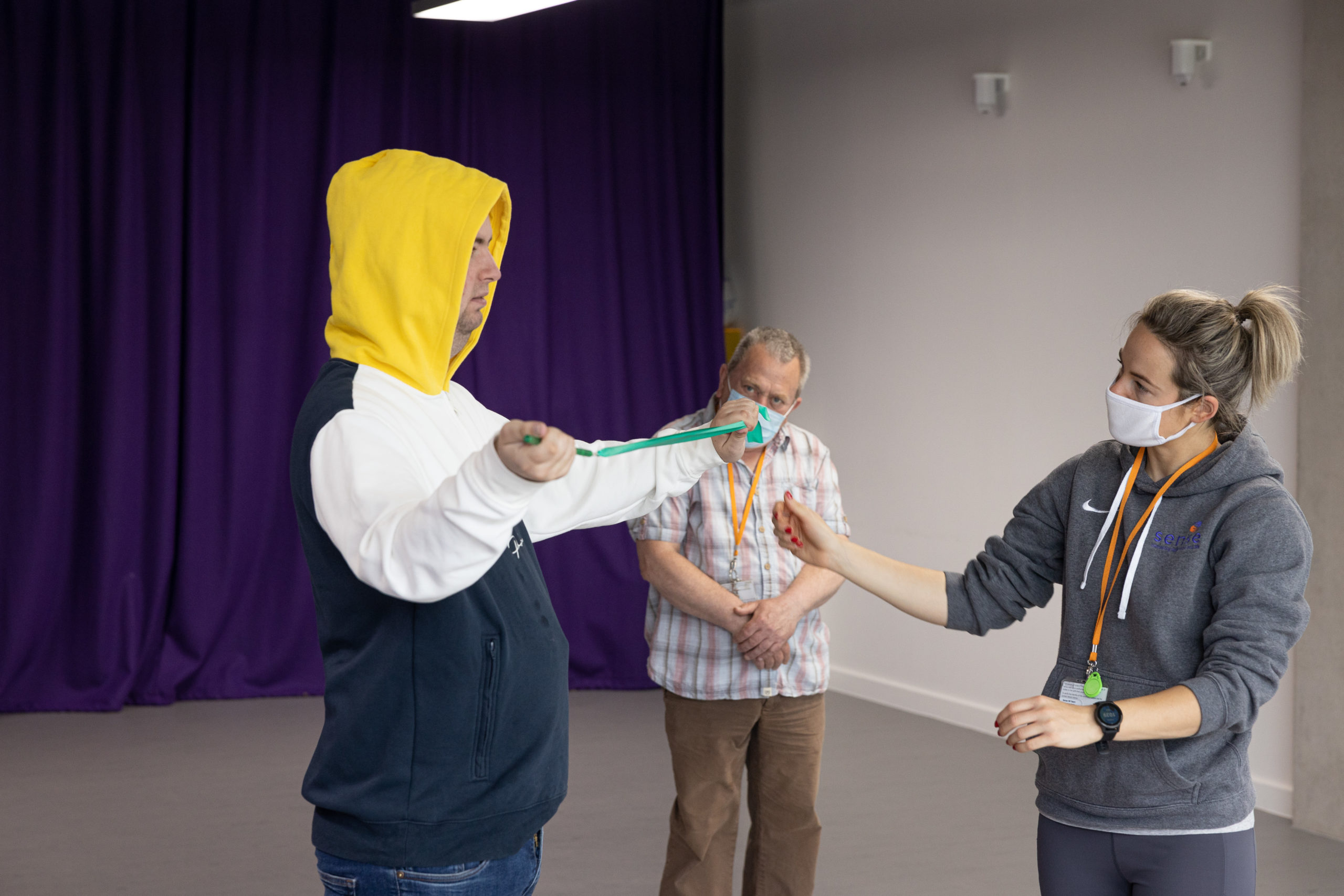
Make it easier
- Suggest pieces of equipment for the participant to explore, and support them to feel and squeeze each item.
- Spend longer exploring one piece of equipment in more detail.
Make it harder
- Try exploring new, different pieces of equipment.
- Encourage the participant to interact with a number of different balls in a specific amount of time. Can the participant notice how they differ in shape, size, weight and texture?
Encouraging Movement and Interaction
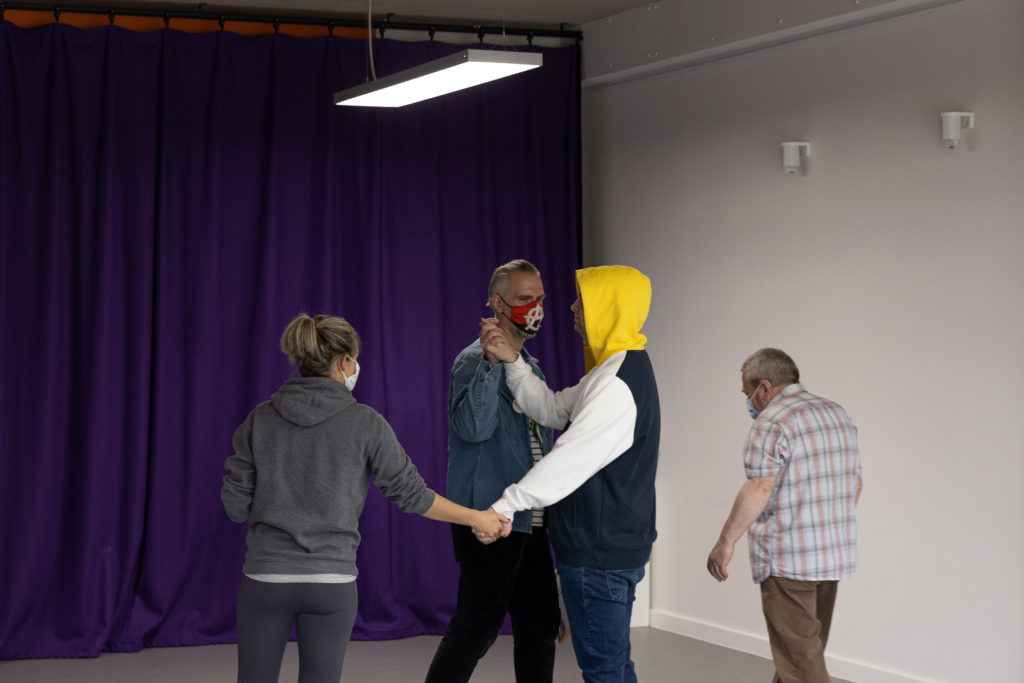
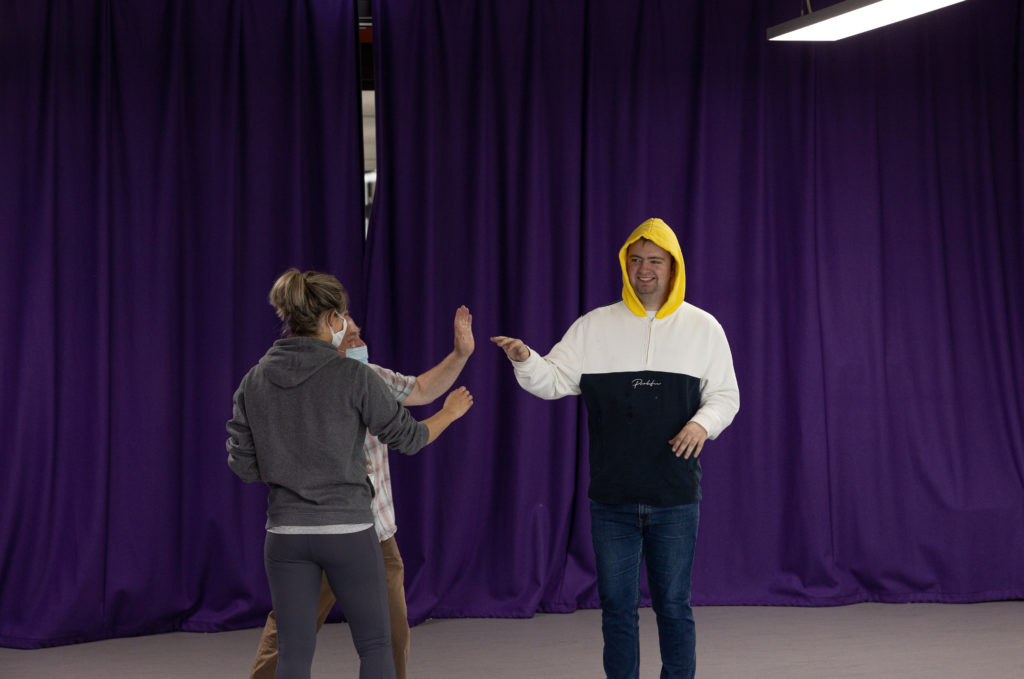
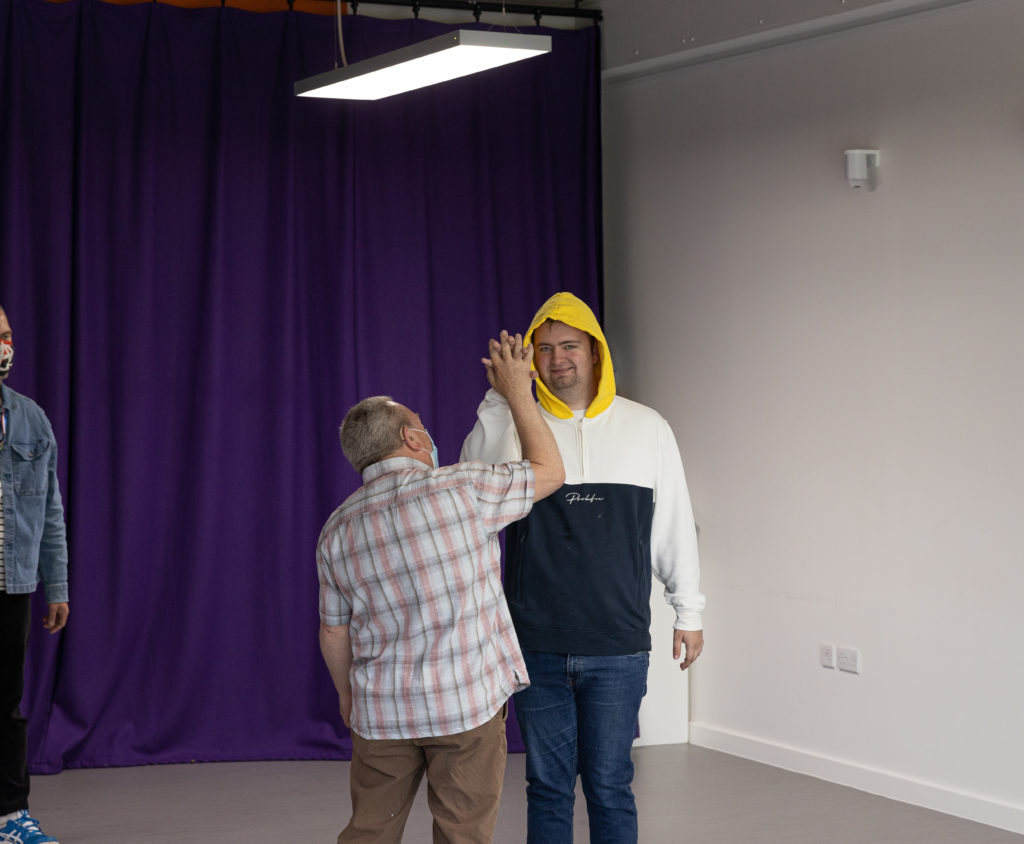
Make it easier
- Support staff actively approach and make contact with participants.
Make it harder
- Encourage participants to navigate the space and initiate high fives more independently.
- High five as many people as possible in an allotted time, for example five people in one minute.
- Rather than high fiving, connect with others using a different part of the body (e.g. foot to foot or shoulder to shoulder).
- Connect everyone in the group to form a big chain, with participants taking it in turns to move along the chain, feeling the connections between each person.
- Reach up high or crouch down low to make connections.
Kick off
Aims and outcomes
Aims
- To signal the start of the sensory football session.
- To prepare the participants mentally for the activity they are about to do.
Outcomes
- Communication
Create your kick off
Create something which represents the start of the football session.
This could be a sound, colour, texture, movement or gesture, which participants understand to mean “we are ready to begin”. Come up with something which is meaningful for everyone in the group.
- A BSL sign for “go”
- A thumbs up
- A green cone
Top tips
- Whatever you choose, it’s important that it holds meaning and is understood by the participants.
- This should be repeated at the same point every week, in order to help participants recall what activity they are about to take part in, and prepare them for this activity.
Tackling
Aims and outcomes
Aims
- Making physical contact with others.
- Using body strength.
- Being competitive with an opponent.
Outcomes
- Health & Fitness
- Choice
- Exploration
Resistance bands
- Face opposite one another, each holding onto the same resistance band.
- At the same time, each use your arm strength to pull the resistance band away from one another, stretching the band and creating tension.
- Try holding this for 3 seconds and repeat 10 times. As the participant improves, increase the hold to 5 or 10 seconds.
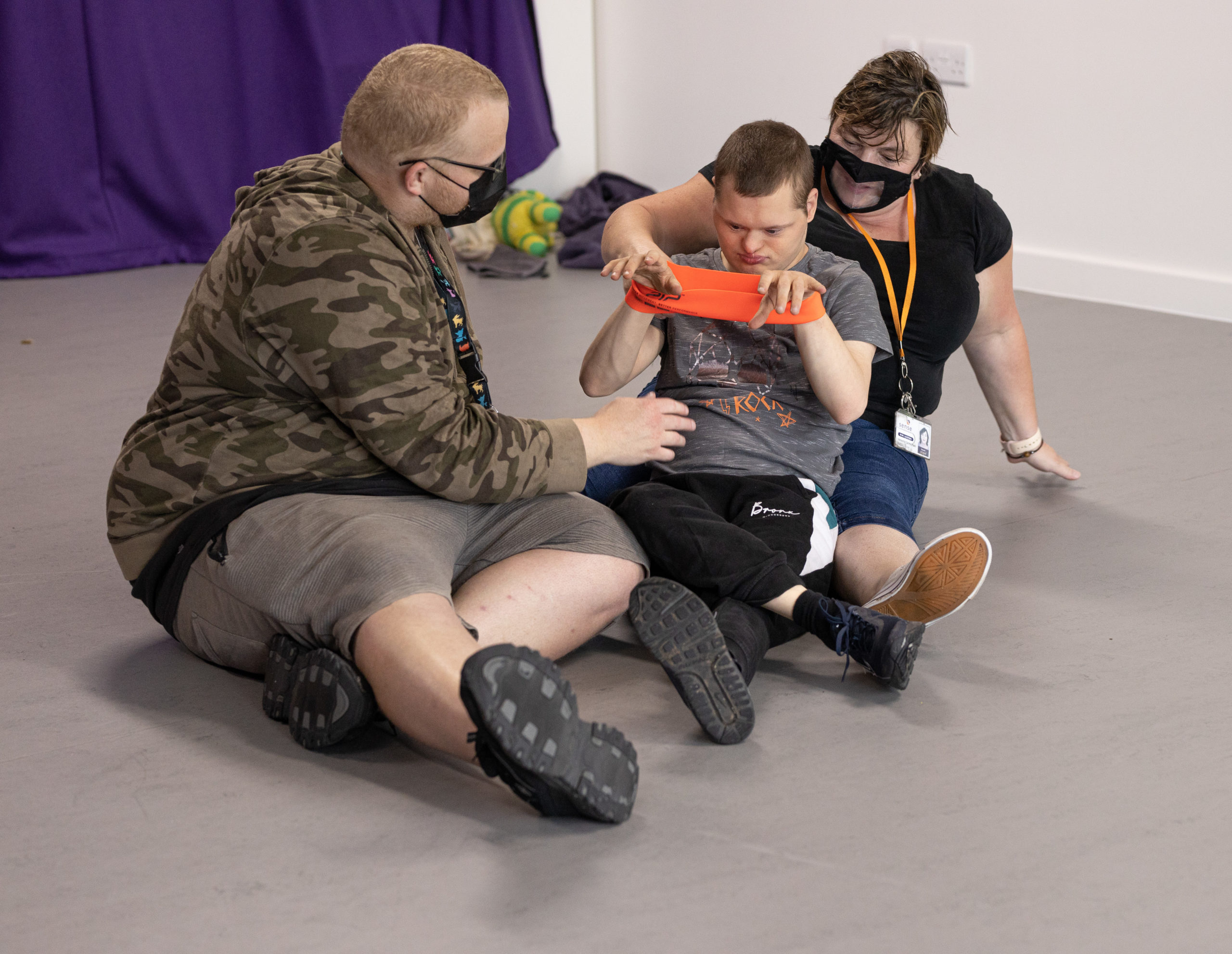
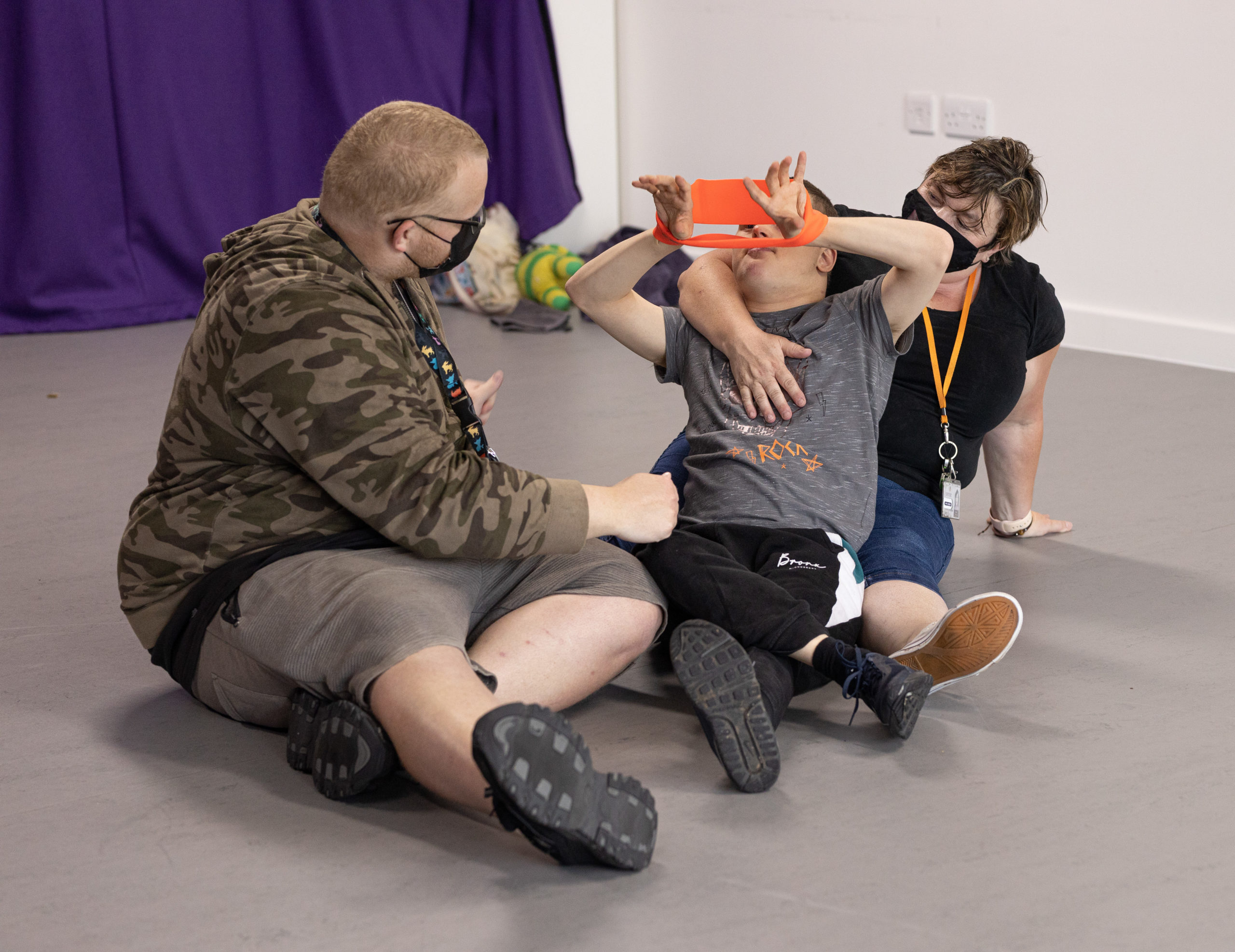
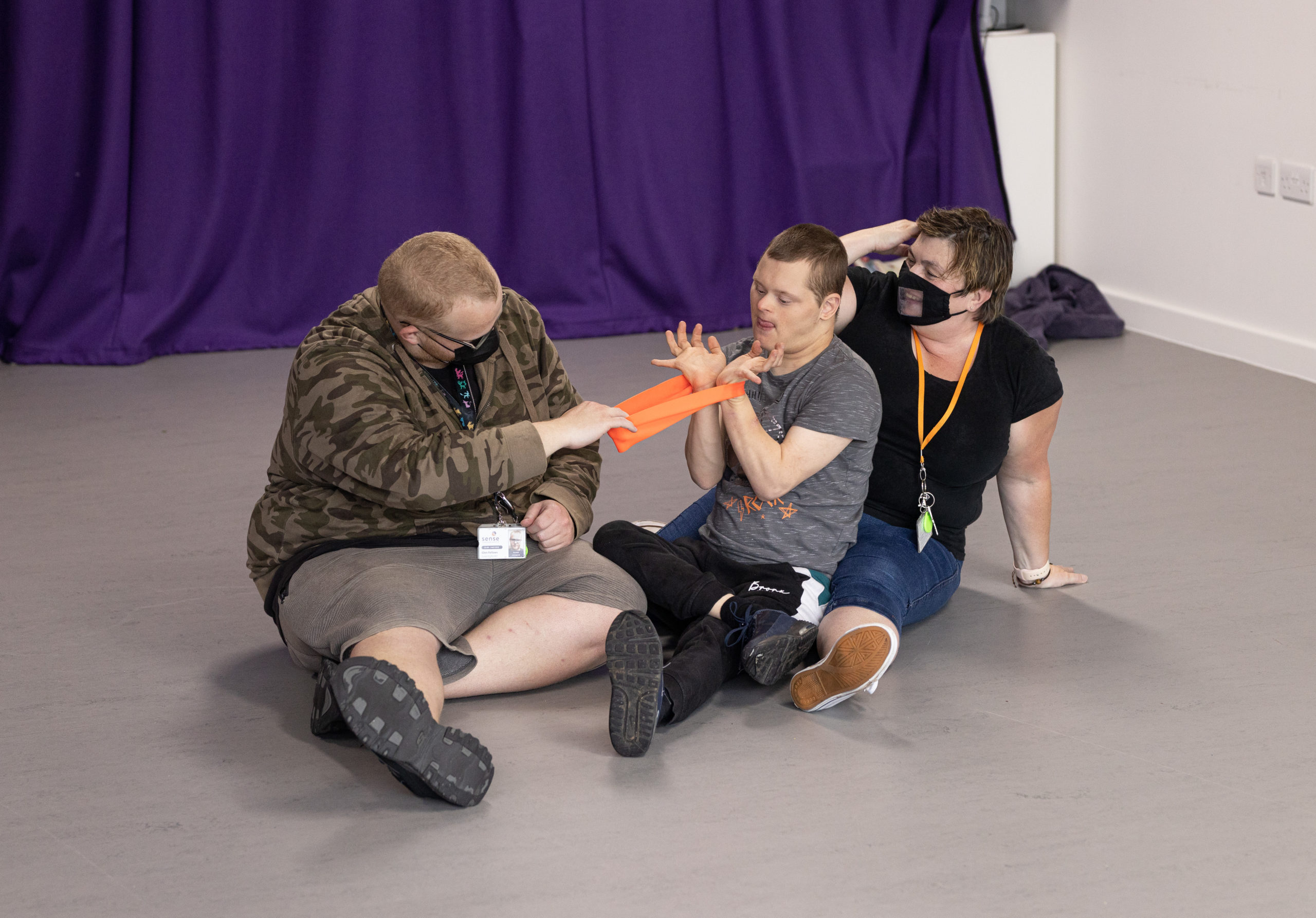
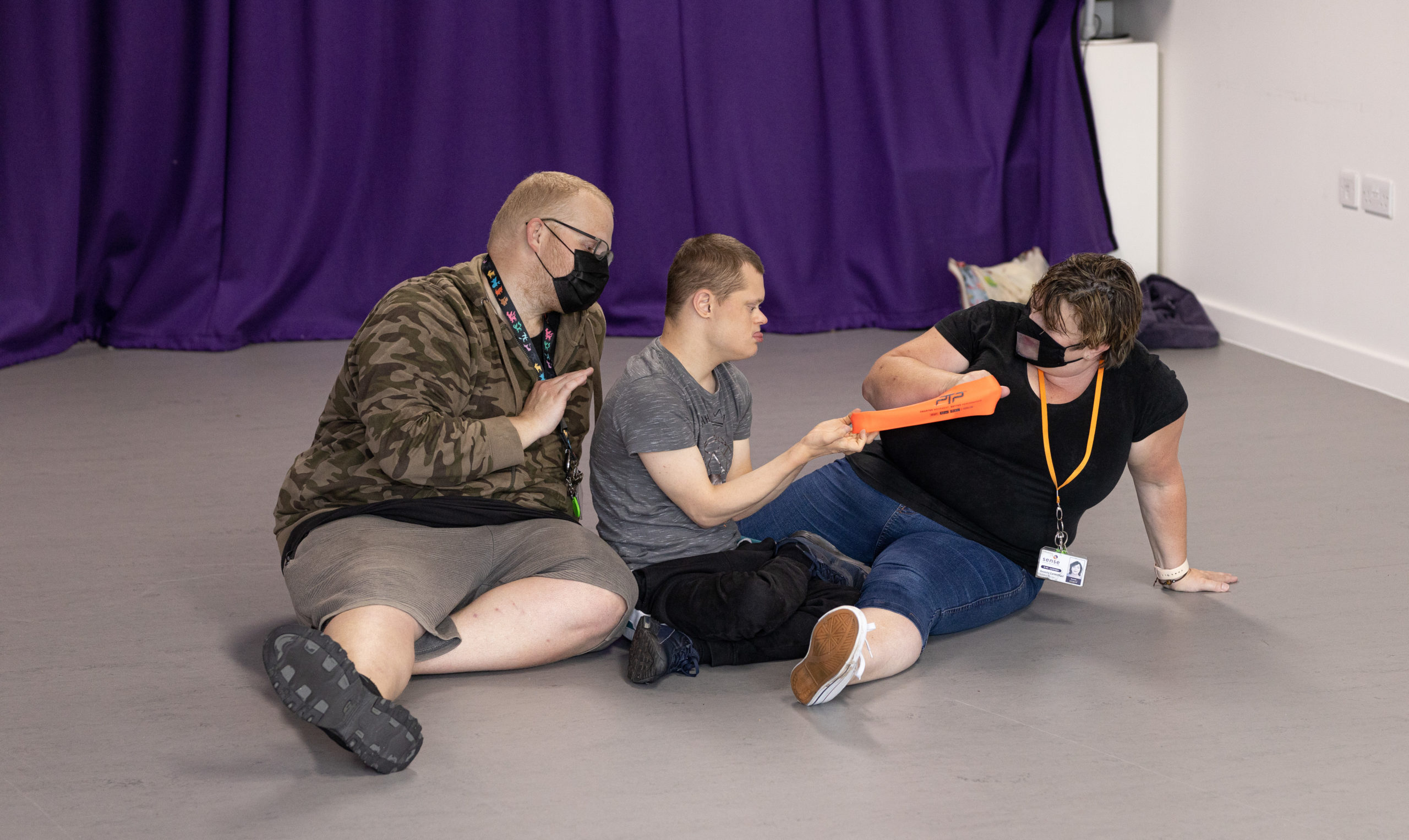
Make it easier
- Loop the resistance band around a participant’s hand and gently pull to create force on the band.
- Stretch the band with both hands and encourage the participant to feel the stretched band so they can experience the sensation of the tension being created.
- Complete the activity sitting down.
Make it harder
- Use thicker or heavier bands.
- Pull the band from below, up high, or from the side, to develop strength in a range of muscles.
Top tips
If you haven’t got a resistance band, you could use a soft or stretchy item such as a tea towel. Be careful of using anything which may snap and cause pain, could wrap around a hand too tightly or ingest, such as a small elastic band.
Physical Contact
- Stand or sit side by side with your partner.
- Use your upper body strength to push against each other at the same time.
- Try pushing for 3 seconds, and repeat 10 times. As the participant improves, increase the hold to 5 or 10 seconds.
Make it easier
- Complete the activity sitting down, side by side.
- Gently apply force with your body and allow the participant to experience the sensation.
Make it harder
- Rather than pushing against each other with your upper body, sit opposite each other and push the soles of your feet against your partner’s, or stand opposite each other and push your palms against your partner’s.
Top Tips
Some participants may not enjoy the sensation of physical contact. If this is the case, continue with the resistance bands activity on page 20 to introduce the concept of force and strength.
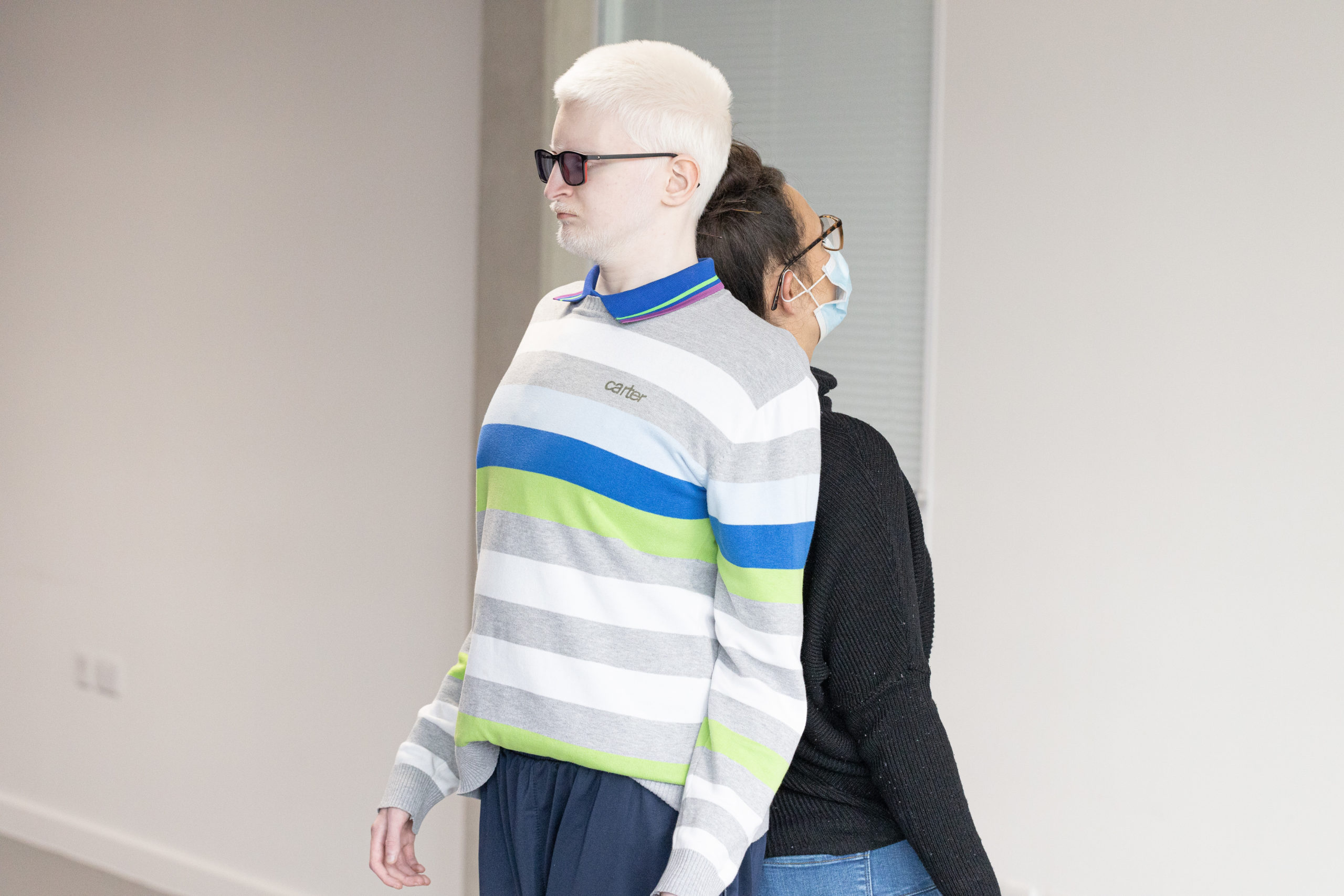
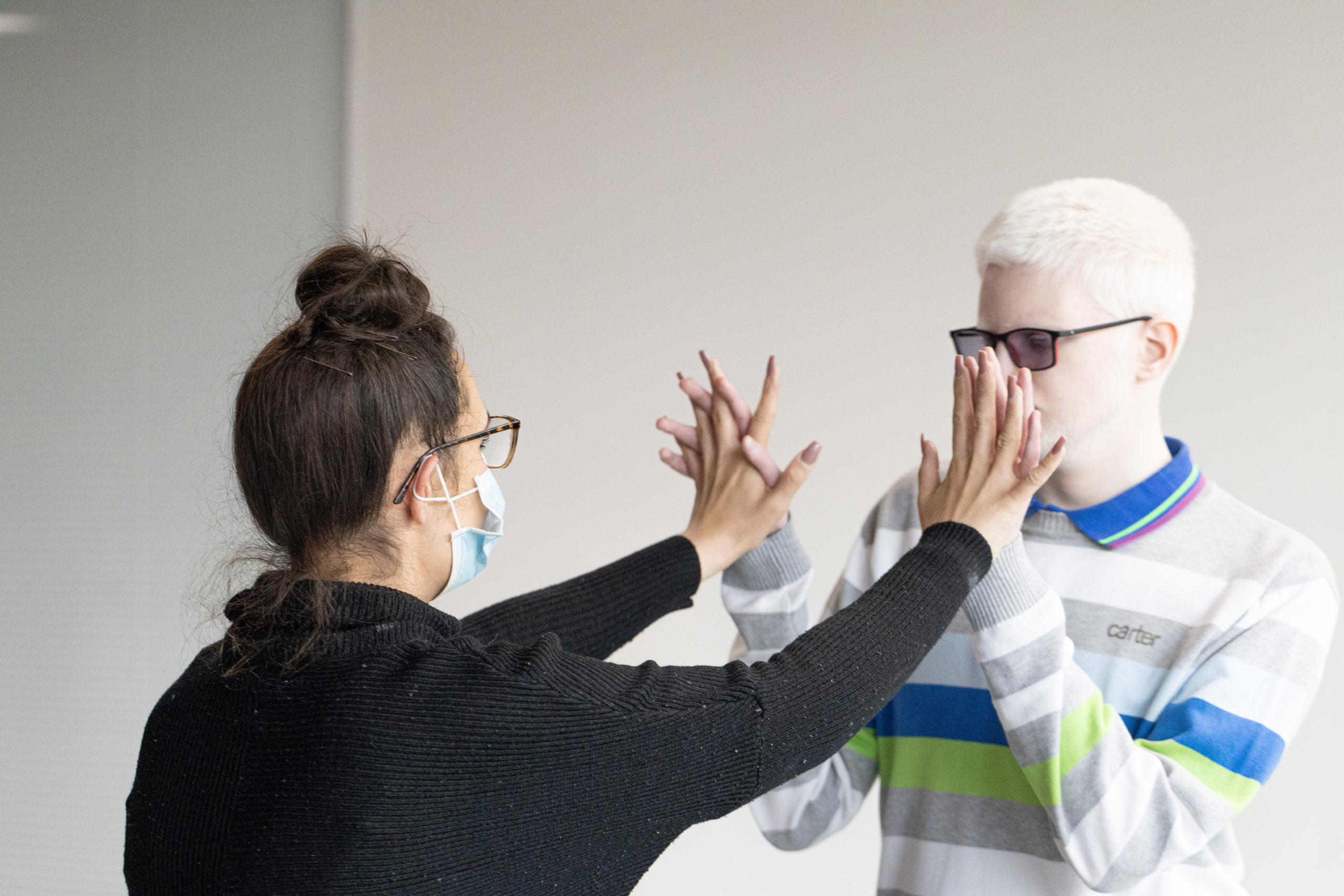
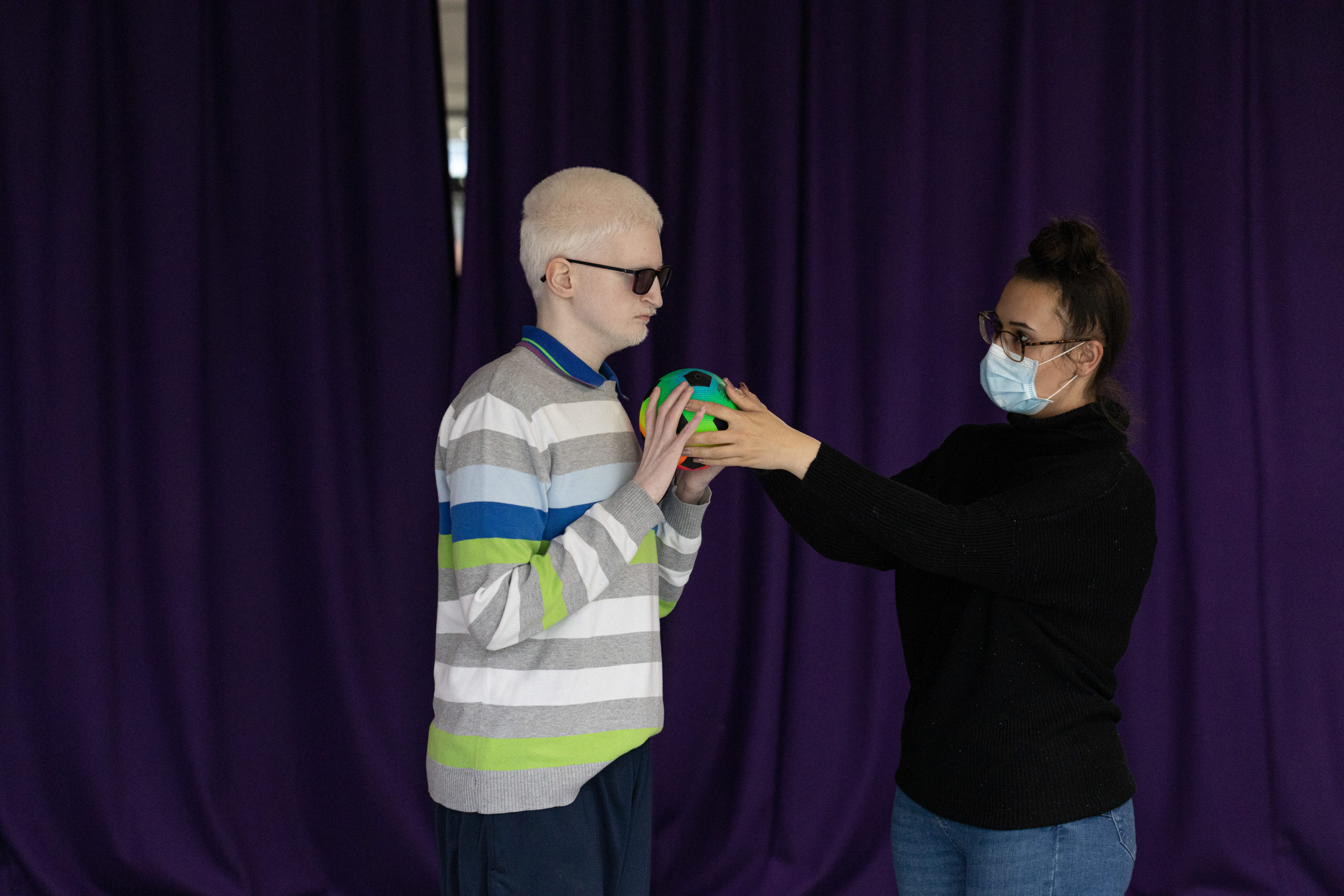
Passing
Aims and outcomes
Aims
- Possessing and releasing.
- Transferring an object to someone else.
- Receiving an object from someone else.
Outcomes
- Try something new
- Communication
- Exploration
Try completing each of the following 10 times:
Grip and release
- Select a ball or object and focus on holding and squeezing it, before letting go of it.
Transfer
- Face your partner, a metre or so apart, sitting down or standing up.
- Roll, bounce or throw the ball to your partner.
Receive
- Now have your partner roll, bounce or throw the ball to you.
- Focus on anticipating where the ball is coming from, and bringing it under control and into your possession.
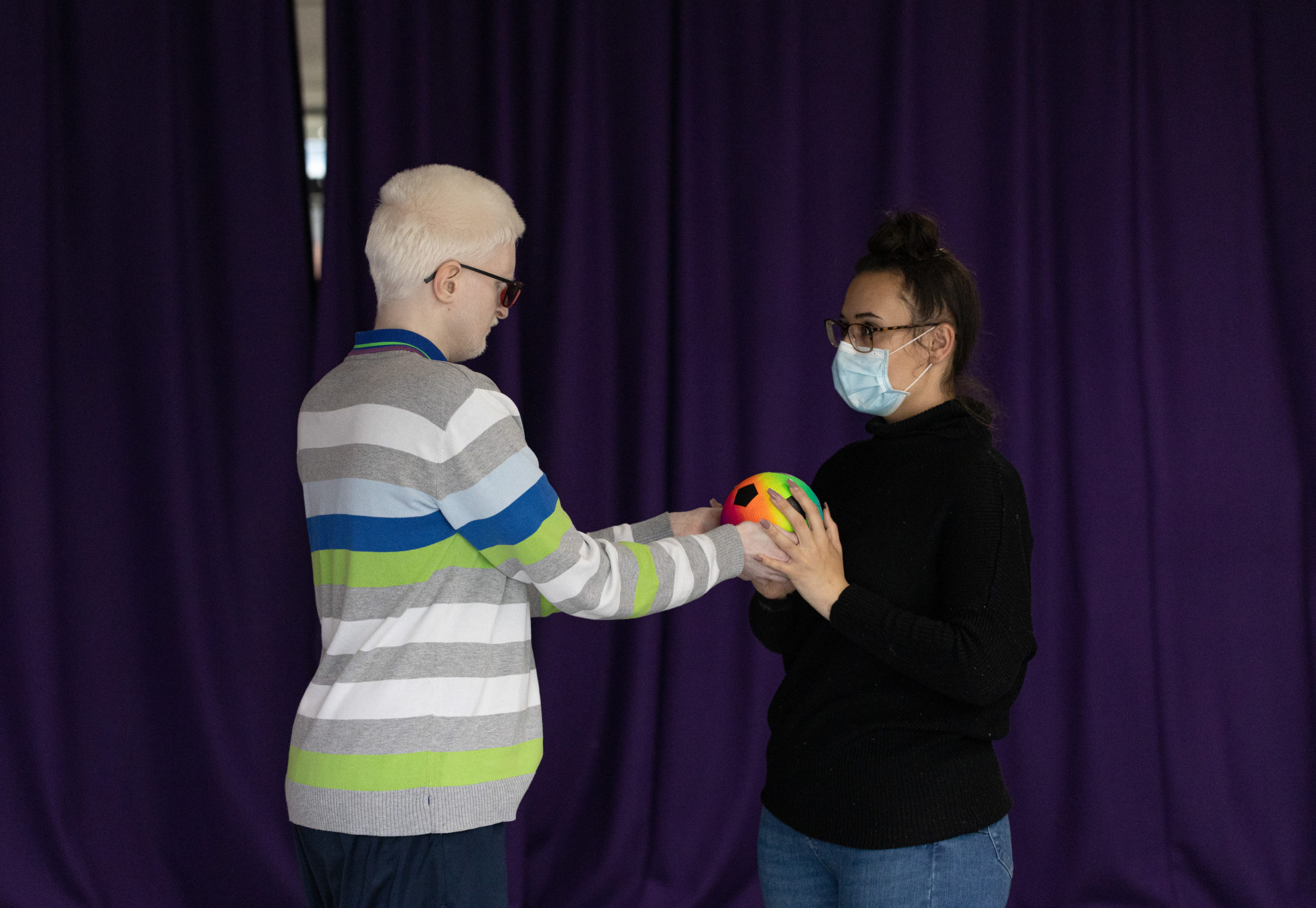
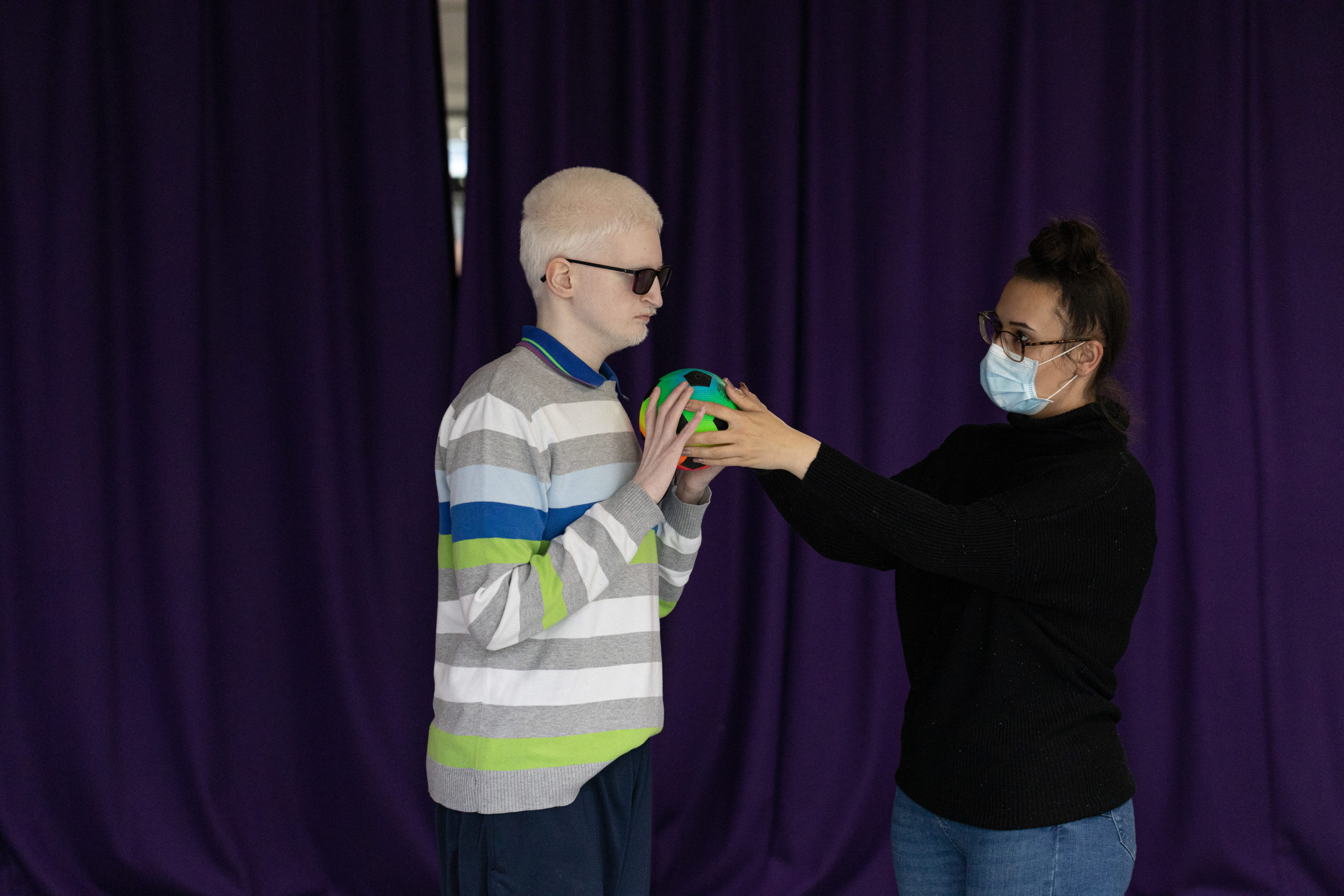
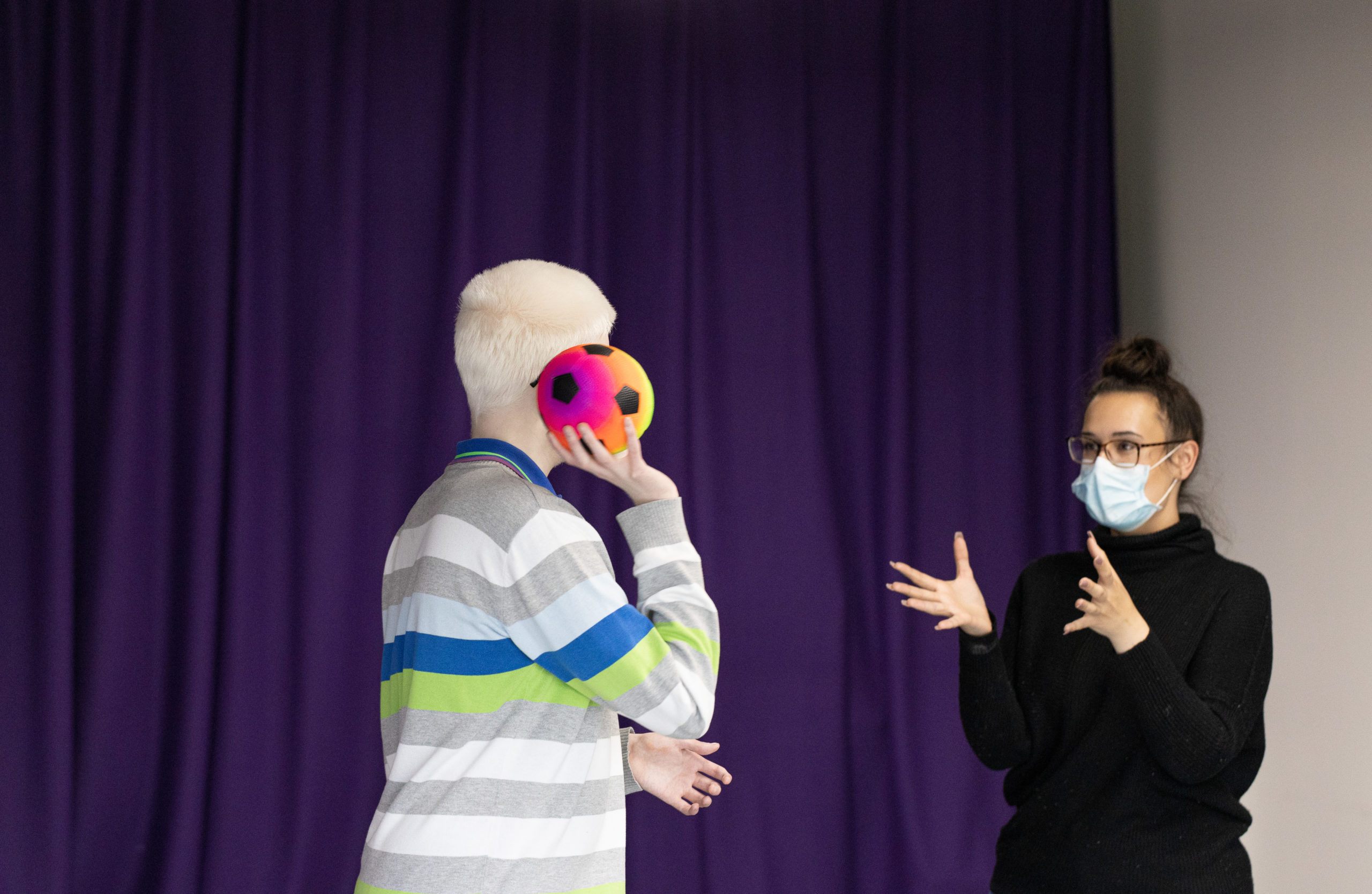
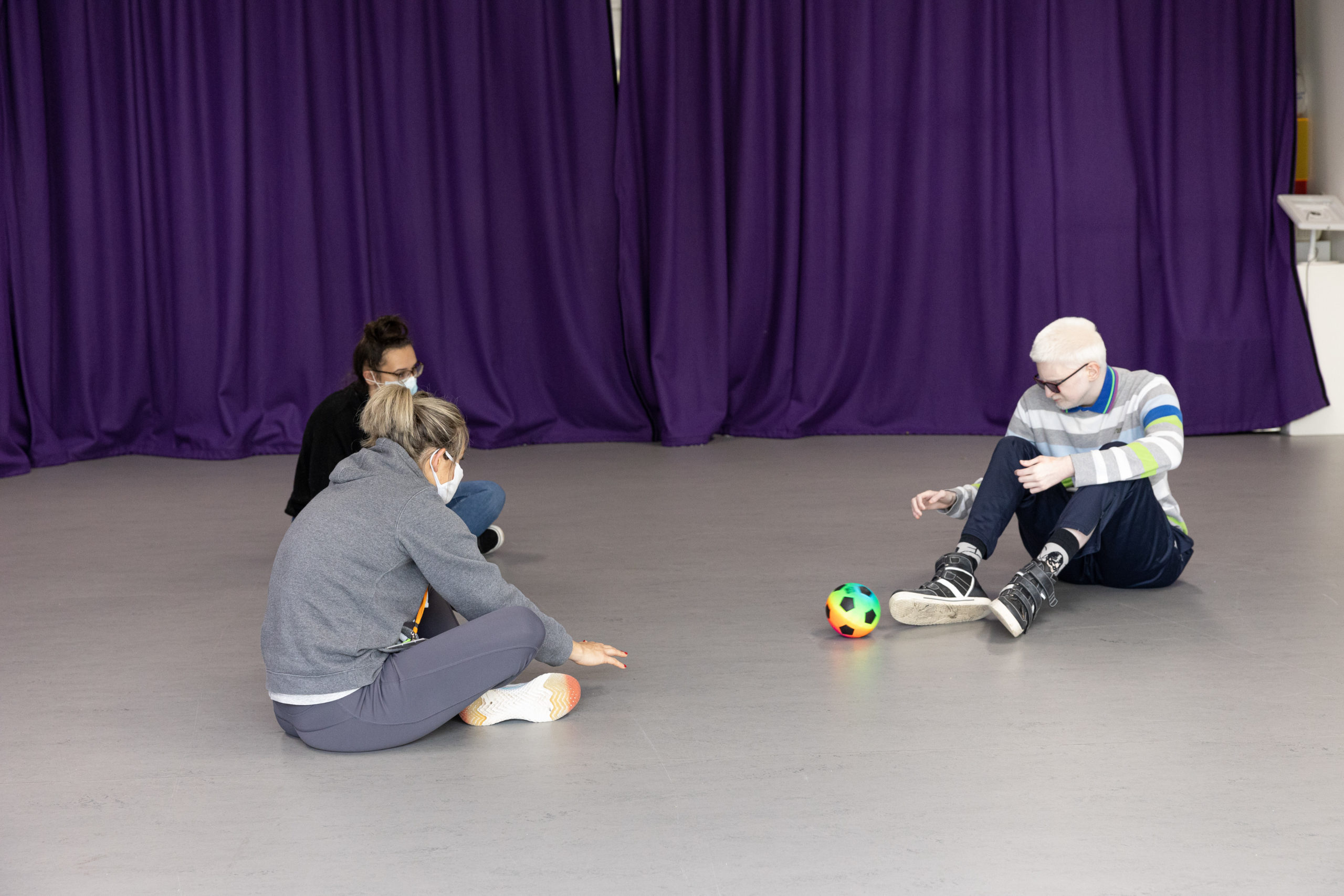
Make it easier
- Face one another, both holding onto the ball at the same time. Push and pull the ball back and forth between one another, whilst still holding onto it.
Make it harder
- Increase the amount of participants to 3, 4, 5 or more, forming a circle, meaning each participant has to make a choice about where to release the ball, and understand that it may be coming towards them from a range of different angles.
Scoring
Aims and outcomes
Aims
- Celebrating acheivements
- Sharing in them with others, creating togetherness
Outcomes
- Independence
- Fun
- Skill development
Goal scoring
- Set up two cones (or chairs, or another suitable pair of objects) as shown in the image below.
- Starting a couple of metres away, kick, roll, throw, bounce or carry the ball in between the two cones.
- Once the goal is scored, everyone within the session (not just the goal scorer) collects a colourful ribbon or flag, and waves it around, or claps their hands, cheering and making and much noise as possible to celebrate the goal!
- Each participant takes it in turns to score a goal, followed by a group celebration. Repeat 3 times each.
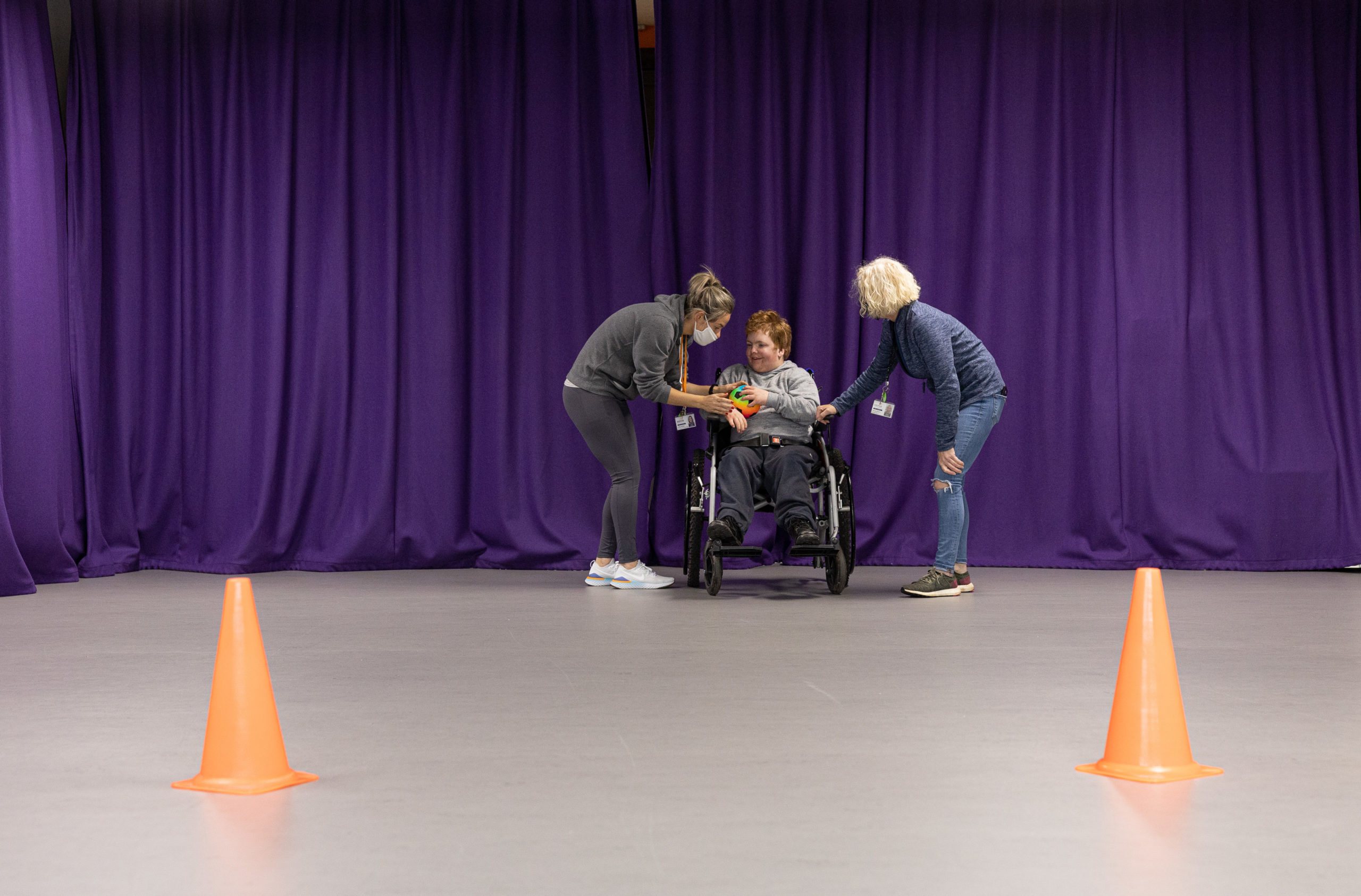
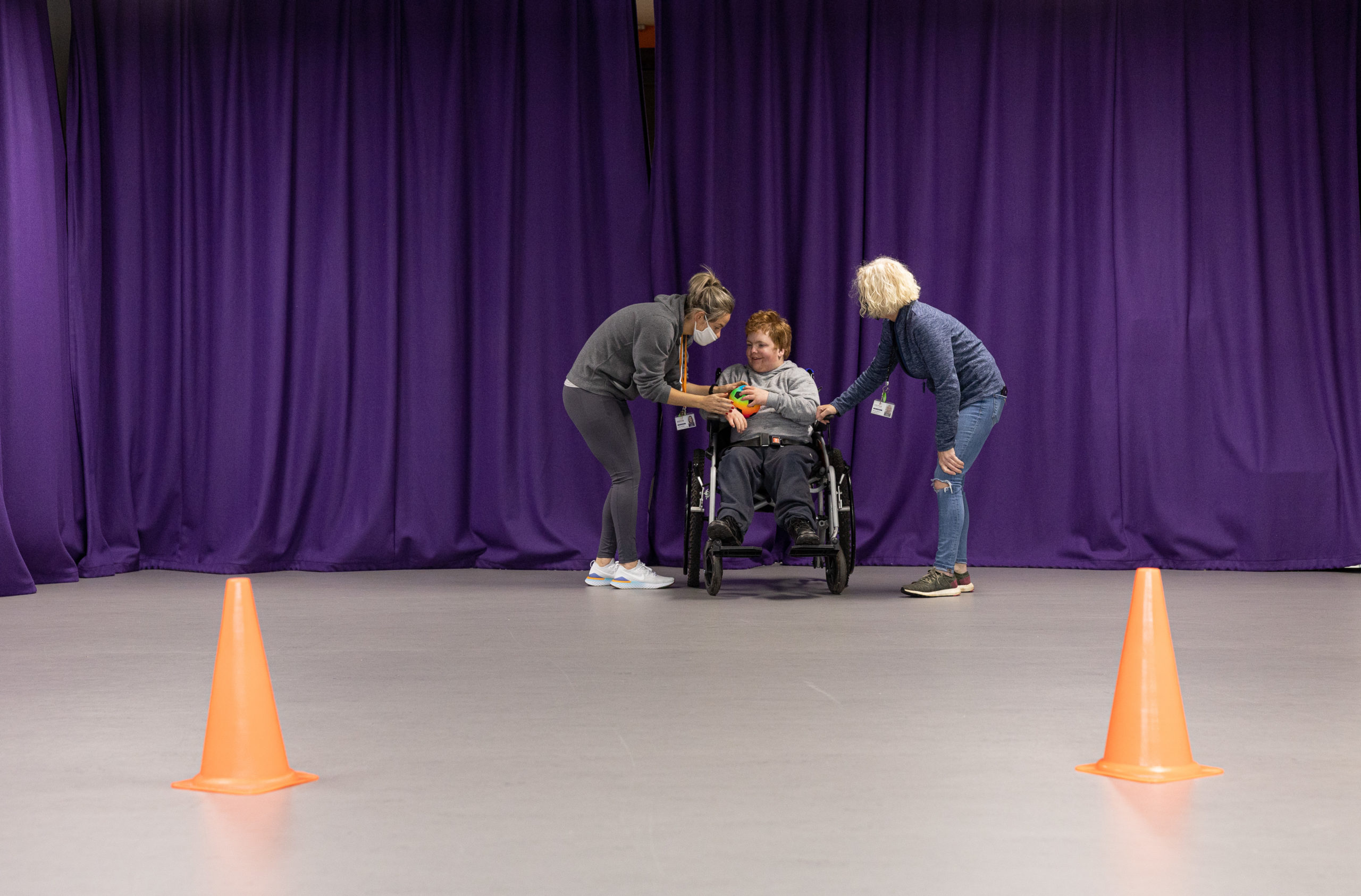
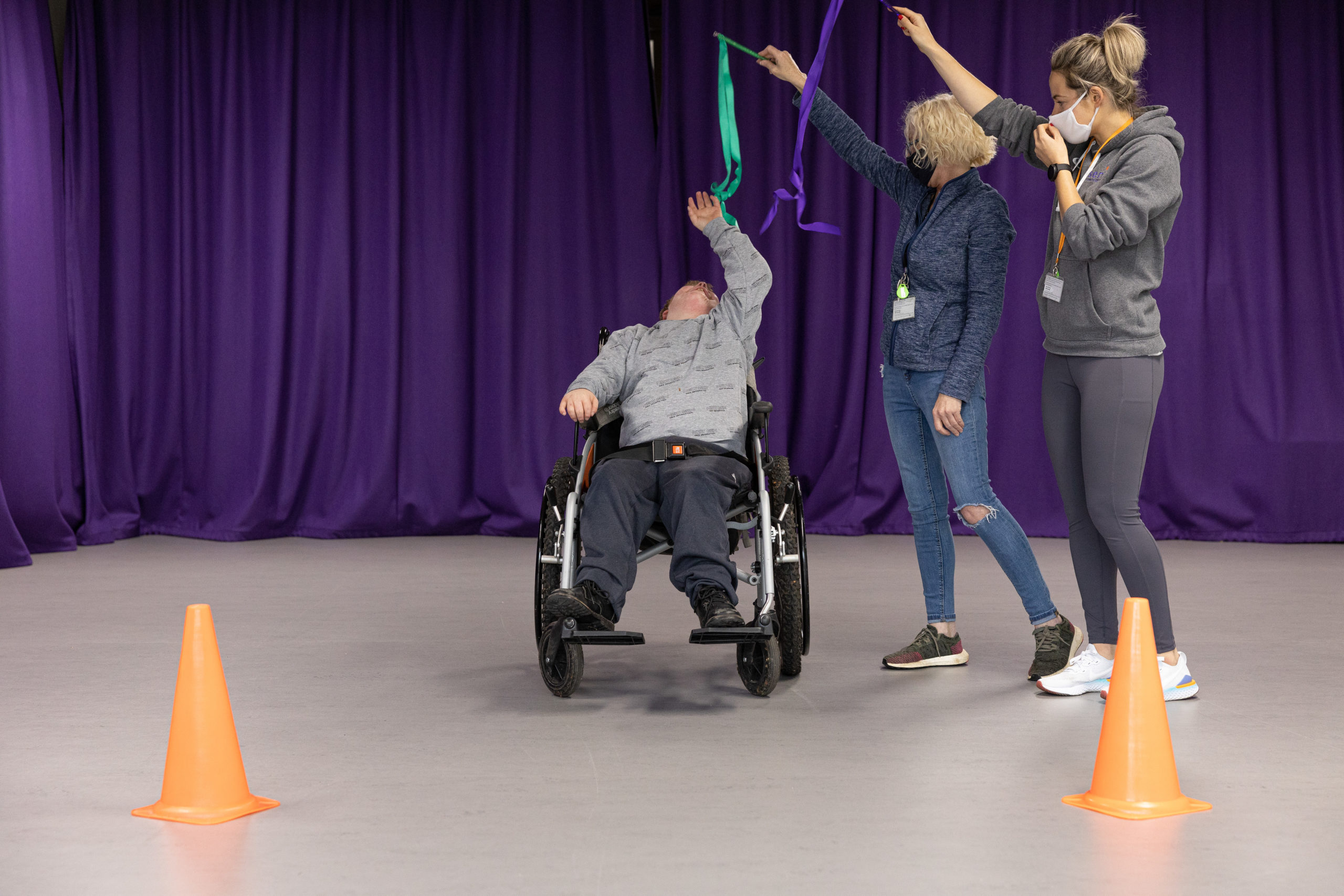
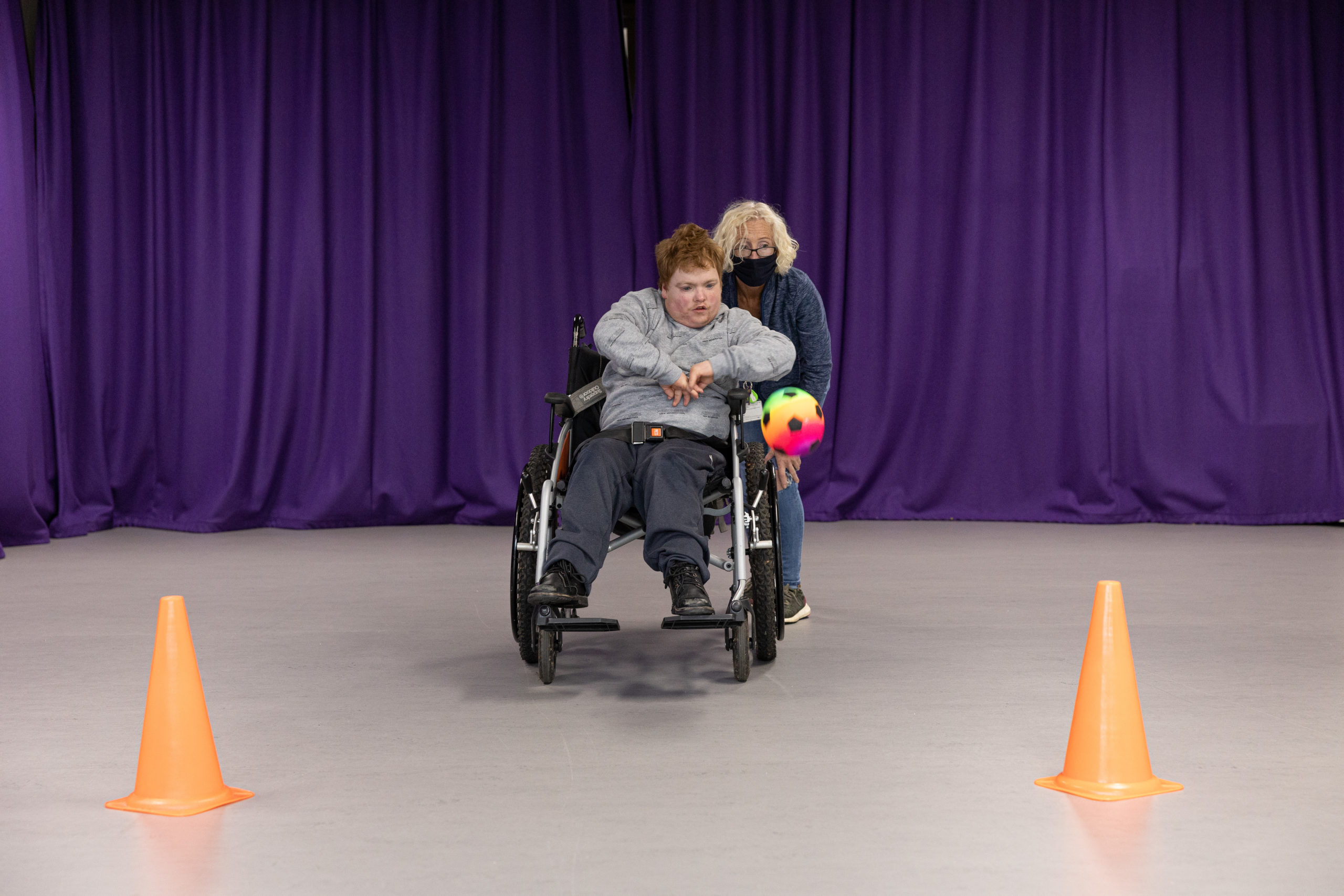
Top tips
- Reinforce the achievement of scoring a goal by repeating the celebration process each time a goal is scored.
- Once confident with one method of scoring a goal, try out different ways of moving the ball through the goal (for example rolling, kicking, or running with the ball).
Make it easier
- Spend some time mapping out the goal area in a tactile way, to understand it’s size and distance.
- Run, walk, wheel, crawl or shuffle through the goal, holding onto the ball.
- Make the goal bigger, or start closer to the goal.
Make it harder
- Make the goal smaller, or start further away.
Final whistle
Aims and outcomes
Aims
- To signal the end of the sensory football session.
Outcome
- Communication.
Create your final whistle
Create something which represents the end of the football session. This could be a sound, colour, texture, movement or gesture, which participants understand to mean “we have now finished”. Come up with something which is meaningful for everyone in the group:
- A BSL sign for “finished”.
- A round of applause.
- A red cone.
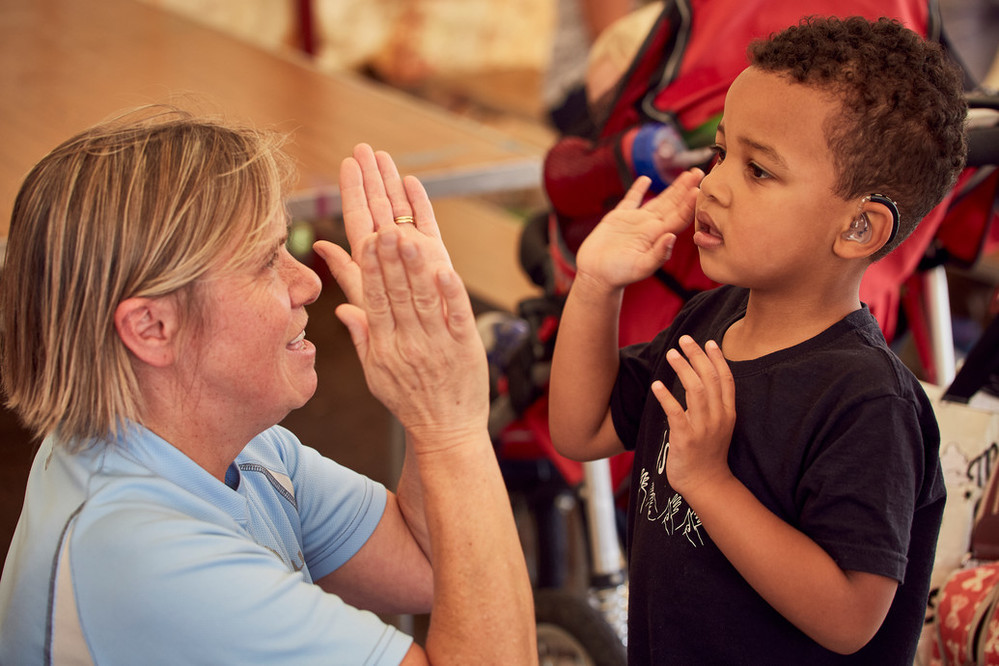
Top tips
- Whatever you choose it’s important that it holds meaning and is understood by the participants.
- This should be repeated at the same point every week, in order to help participants understand that they have now come to the end of the sensory football session.
Section Three: Evaluating your Session
It’s important to evaluate each session, to ensure you are meeting the needs of your participants, and that they are experiencing the benefits of taking part.
We recommend doing this immediately after each session, whilst it is fresh in your mind. There are two different areas to consider when conducting your evaluation:
1. Person-centred evaluation
A person-centered evaluation involves considering the experiences of each participant. It’s useful to involve the support staff, as they will have been working closely with the participants during the session and can give a more detailed account of the individual’s engagement.
Consider the following:
- Skill Development – are participants demonstrating new or improved skills which they have not done previously?
- Strength, flexibility and movement- are the participants able to stretch further, hold or grip objects better, or move more quickly?
- Social interactions- are participants making more contact with their peers and others around them? This could be in a number of ways including verbally, through sign or touch.
- Sharing a group environment- do participants appear more comfortable, calm and relaxed in a group and a sports-based environment?
- Independence- are participants able to complete tasks or movements more independently, regardless of how small or subtle, that they were not able to before?
- Recall and anticipation- Do participants remember the activities from week to week, and recognise intuitively what it is they will be doing next?
Compare each participant over a period of weeks, and notice how they develop week by week in relation to the above areas.
2. Observation of session delivery
Think about how the session was delivered by the session leader or coach.
How was communication used?
- Did the coach give the staff and participants clear information, using a variety of methods?
How was mobility supported?
- Did the coach help the staff and participants to understand and negotiate the environment?
Was enough time given?
- Was there sufficient time for the activities? Did the coach follow the pace of the participants and respect their choices? Were participants in control of each situation?
How did the coach maximise the experience for the participants?
- Did they allow participants to try new things for themselves? Did they adapt the activities based on the needs of those taking part?
Key points to consider
1: Support staff will know the participants best, and will be working with them closely throughout the session.
Therefore, try to empower them to adapt the activities to support or develop the participants as they see fit. For this, they may need to use their initiative and be creative- encourage this!
2: Don’t worry if things take longer than expected to deliver, or it takes participants longer than expected to move through the activities.
Focus on getting good quality engagement and outcomes from the session, even if this means moving through the activities more slowly, or focusing only on one part of the session.
3: Due to the complex disabilities of the participants involved, developments may not be apparent straight away.
Try to focus on the outcomes listed earlier in this resource, not just on participants’ “football skills”. For example, some people find being in a group with others challenging.
If this was to improve over a number of sessions, this is a huge achievement that should be acknowledged.
4: After a period of time, participants may begin to recognise and complete tasks more independently.
“She has become more engaged with staff and more interested in interacting with them.”
FA Level 2 Football Coach
5: Behaviour change may be very subtle, so work with staff, carers or family members who know the participant well to identify small, positive changes.
6: A weekly observation of a participant may be influenced by who is making the observation.
Having the person working with and evaluating a participant’s progress each week helps provide consistency and a more reliable comparison.
7: Repeating the same activities over a number of weeks, with progression where possible, is key to the learning process for many individuals with complex disabilities.
Try to maintain a routine, with weekly sessions at the same time and place if possible, to enhance the learning process.
“The pupils are understanding the concept of the goal section much more and will sit on the bench, waiting their turn, and know what to do with the ribbons.”
Teacher – SEN School
8: Sensory football activities work best when there is adequate support for everyone in the group, to engage with and explore the activities.
9: There are many factors outside of your control which may impact the delivery of a sensory football session, such as unforeseen disruptions or challenging behaviour.
Remember it is ok to repeat activities, scale them back or move through them slowly if required.
“I decided to go to the classroom before each session to explain to the pupils and staff what we were doing in the session, then walk to the hall with the class and let them explore as soon as they went in. This seemed to improve behaviour, as the pupils didn’t have to come into the hall and sit down to wait for instructions, they could be active straight away.”
Teacher – SEN School
Suggested equipment list
Sensory football sessions are designed to be delivered with minimal equipment, using whatever you have available. Think about making them sensory by using different textures, sizes and colours.
A sensory football equipment bundle can be purchased by contacting Sense active by emailing us at [email protected].
To get the most out of the sessions, you may wish to purchase the following:
- Resistance bands
- Ribbons
- Balls
- Cones
Practical delivery template
Although Sensory football is designed to be easy to pick up anywhere at any time, you may wish to plan your sessions to ensure the activities you deliver are supporting participants to meet their desired outcomes.
Use the below planning template as a guide, or come up with your own. It is important to consider outcomes, and then use creativity to come up with activities which will help participants to achieve these.
| Desired Outcome | Football Topic | Activity | Length |
| Preparation for activity | Kick off | All hold up green cone | 5 mins |
| Improved Communication | Warm up | Mapping the space Mapping the equipment Encouraging movement and interaction | 5 mins 5 mins 5 mins |
| Improve strength | Tackle | Resistance band pulls | 10 mins |
| Building social skills and confidence | Goal scoring | Goal scoring | 10 mins |
| Understanding that the session is coming to an end | Final whistle | All use BSL sign for “finished” | 5 mins |
Stay connected
We’d love to hear what you think of this resource. How have you been using it with the people you support? Has it changed the way you deliver football, or activities in general? Have some of your participants health, skills or confidence improved?
Please let us know by emailing [email protected], and we’ll be in touch to find out more. You can also ask us questions or for support in running sessions.
You can also stay connected through Twitter by tagging @Sensecharity and including #SenseActive
Acknowledgments
This resource has been created by the Sense Active team however would not have been possible without the help of:
- Jo Stokes, Rebecca Light and the Sense Practice Development team
- Kris Tavender and Bristol Bears Community Foundation
- Old Park School- Brierley Hill
- Gaz Davies- Sense Operations Services
- Sense Residential Services
- Aurora Meldreth Manor, Cambridgeshire

